
April 2024 | kcgmag.com GARDENER The Kansas City Rose Report | Ask the Experts | Hummingbirds Reimagining Lawns | The Dirt on Planting Fruit Trees The Secret to Successful Butterfly Gardening: Host Plants
The Kansas City
Independently owned and operated since 1996
PUBLISHER
Michael Cavanaugh
EDITOR
Elizabeth Cavanaugh
CONTRIBUTORS
Matt Bunch
Alisha Galloway
Lenora Larson
Dennis Patton
Judy Penner
Tamra Reall
Anthony Reardon
Sarah Sikich
Elizabeth Stoakes
Denise Sullivan
Anne Wildeboor
Scott Woodbury
DISTRIBUTION Publishers Delivery Solutions, Inc.
IF YOU WOULD LIKE TO DISTRIBUTE the magazine at your place of business, please contact
Mike Cavanaugh at mike@kcgmag.com
913-648-4728
NEED MORE MAGAZINES? mike@kcgmag.com
913-648-4728
CONTACT US
P.O. Box 8725 Prairie Village, KS 66208 913-648-4728
ADVERTISING
Mike Cavanaugh at mike@kcgmag.com 913-648-4728
EDITORIAL
Elizabeth Cavanaugh
913-648-4728

editor’s notes A Garden Entry
Flip flops and wool socks litter the entryway. All sweaters were laundered ready for storage. Linen pants made their way to the front of the closet. And then wonky weather patterns set in motion the need for a winter hat one day and a spring skirt the next. Of course, this is classic Midwest weather. Inconsistent and sometimes frustrating, where temperatures vary 20 or 30 degrees from one day to the next. Do I need a coat or just a sweater? Can I get away with sandals, or do I need socks and shoes? I’d love to wear a dress instead of long pants. Such are the wardrobe challenges of early spring.
By the time the calendar rolls over to Tax Day (April 15) though, temperatures start on a consistent track, back to what is normal this time of year. We’ll put out the hummingbird feeders, arrange containers for planting annuals, and find those seed packets ready for direct sowing.
If you are like me, you have already pulled back the mulch layer in search of perennials reaching for the warm sun. It continues to amaze, and arouse my curiosity–how does that even happen? How in the world do those hosta leaves know when it’s time to push
through that insulating layer? I still marvel at the sight.
Mr. Gardener and I have initiated another phase of garden renovation. After 20 years of distinguished service, tolerating snow, ice and gusting winds, the stand of evergreens that borders our property have got to go. Having lost the uniform shape caused by an ice storm long ago, they no longer serve the intended purpose. We are replacing them with Prague Viburnum, an evergreen shrub that is known for its glossy leaves and fragrant blooms. Fast growing, they will reach 8 to 12 feet tall and 6 to 8 feet wide. This is a new introduction to the garden, so I’ll report back with performance results.
And now…{long pause}…
The gardening community has suffered a great loss. It is with deep sorrow that we acknowledge the passing of our dear friend, Dennis Patton on March 16. With the heart of a teacher, he was honest, humorous, and knowledgeable about all things gardening. Since the launching of this magazine nearly three decades ago, we have been the beneficiaries of Dennis’ willingness to share his expertise month after month. Our hearts ache, and yet we can’t help feeling joy. Dennis has been released from the suffering of

disease, and has transitioned to the life of light and peace. In the May edition, we will properly honor Dennis and his gardening legacy.
I’ll leave you with this: Tell people how you feel about them. Write a thank-you note. Be spontaneous about showing affection. And always (in all ways) show your beloveds how much you love them.
WEBSITE

I’ll see you in the garden!

GARDENER
elizabeth@kcgmag.com
HOW TO SUBSCRIBE See details on page 31. SUBSCRIPTION Elizabeth Cavanaugh elizabeth@kcgmag.com
913-648-4728
kcgmag.com 2 April 2024 | kcgmag.com About the cover: You’ll never see this Zebra Swallowtail in your yard unless there is a nearby Pawpaw tree, the only plant its caterpillar can eat. Learn about butterfly host plants beginning on page 16. In this issue April 2024 | kcgmag.com 4 Ask the Experts 6 Kids Ask Dr. Bug 8 Rose Report 10 Hummingbirds 12 Plants on Your Plate – Arugula 14 UPCLOSE 16 The Secret to Butterfly Gardening 20 The Dirt on Site Selection and Planting Fruit Trees 22 Spring Plant Sale at the Arboretum 24 Reimagining Lawns 25 Become a MU EMG 26 Clueless Cultivator 28 Upcoming Garden Events 30 Garden Calendar 31 Subscribe 31 Hotlines

The Kansas City Gardener | April 2024 3
Question: As I plan my garden for the coming year, I think I would like to try a non-chemical approach to weed control. In what ways can I do this?
Anthony’s Answer: While there are many home remedies for non-chemical weed control (often utilizing salts, vinegars, soaps, etc.), many will also have varying effectiveness or sometimes even unintended consequences in the garden. Because of this, physical (mechanical) techniques are some of the most promising non-chemical control methods that can be considered.
Of the more unorthodox options, boiling water and pouring it onto plants or flame weeding and burning plants with a torch are two options that will have a very similar effect to a traditional herbicide. Cells of the plants boiled and ruptured, the plants will wilt and die with minimal effort, with the caveat that the effects of treatment may be hard to relegate to just the desired location. Safety in these options, as well, will require proper precautions not to hurt yourself, or not to set fire to unintended areas.
Heat aside, traditional hand pulling, cultivating, mulching, and relegating of water distribution can all assist in keeping garden weeds at bay, so long as they are done diligently.
LACK OF SUNLIGHT, NOT SOIL PH, CAUSING LAWN PROBLEM
Question: I am attempting to grow grass under my old oak. I was told the oak leaves turned the soil acidic so to raise the pH by applying lime. I did that two years ago and I still have no grass. I give up, what do I need to do to grow grass under the oak?
Dennis’ Answer: You have already answered your own question – give up! The issue is not with the soil but the lack of sunlight. We have no species or varieties of grass that thrives in our climate on low

Ask the Experts


light. The lack of sunlight causes the grass to slowly die out over summer. To maintain grass in this area, overseeding each fall is required. Even then, expect the stand to be thin.
As for the addition of lime, it was probably not necessary nor helpful. Yes, oak leaves acidify the soil as they decompose. But oak leaves do not remain on the ground like the forest floor. They have little or no effect on pH. Leaves will not change the pH of the soil for years, maybe a hundred years. Never apply lime in the Kansas City area without a soil test as local soils tend to already be high in pH. Adding lime can compound this problem.
My advice is to forget grass in the shade. A mulch layer or ground cover is the best long-term solution.
I know it is hard to adjust your paradigm, but it is just not worth fighting for a lawn in the shade.
TOO MUCH COMPOST, IS THERE SUCH A THING
Question: Can I get too much compost and organic matter in my garden soil?
Dennis’ Answer: Great question and the short answer is yes. As gardeners, we recommend the use of compost all the time. It’s nature’s black gold! But like anything in life, there can be too much of a good thing. Ideally, the organic matter content of the soil should be around 5%. Determine the amount of organic matter through soil testing provided by your local Extension office.
High levels of organic matter
in the soil can cause it to become light and airy, thus reducing the water-holding capacity and making the soil difficult to rewet once dry. While it might look like good, fertile dark soil, it does not have enough of our good old clay to create that delicate balance of air and water-holding capacity. It is hard to imagine, but some clay is a good thing.
Organic matter levels break down over time the more you till the soil, so additional applications can help maintain an acceptable level. Gardening in highly organic soils may make tillage and digging a breeze, but water relationships begin to be a challenge.
SEED TAPE
Question: I keep hearing fellow gardeners discuss “seed tape.” What is this? Should I be using it in my vegetable garden?
Anthony’s Answer: In short, seed tape is a method of seed planting that entails pre-spaced seeds that are laid out and buried altogether. This practice is desirable to many, as it can spare the hassle of repeatedly bending over to individually sow seeds into the ground. It can also assist in the spacing of particularly small seeds, that you do not wish to over-germinate in one area, then having to thin later.
Seed tape can be made with just a few standard household items and the seeds that you would like to work with. Cutting a spool of paper towels horizontally from the center, unroll the spool halves and mark the locations where you would like your seeds allotted, accounting for proper spacing. Creating a paste of flour and water, you can then glue to the seeds to the tape by simply applying a dot of the paste over them in their allotted spot.
At the correct time of sowing for the seeds, the tape can be laid at the depth required by the plants and buried. The seeds will germinate through the paste, and the paper towel will eventually disintegrate.
DENNIS PATTON |Horticulture Agents | ANTHONY REARDON
Dennis and Anthony are the horticulture agents for Johnson County K-State Research and Extension, each specializing in ornamentals and edible crops, respectively. For free information fact sheets, visit www.johnson.ksu.edu, or call the Extension office at 913-715-7000.

4 April 2024 | kcgmag.com
NON-CHEMICAL
Forget grass in the shade. A layer of mulch is a better option.
WEED CONTROL
Yes, there is such a thing as too much compost in the garden.
TRIALED & TESTED FOR YOUR SUCCESS































































































































Don’t settle for one-note azaleas; go for the total package: PERFECTO MUNDO® azaleas


Proven Winners® ColorChoice® Shrubs undertook the most extensive trial in their nearly 20-year history to select only the very best from hundreds of plants to make the Perfecto Mundo reblooming azalea series as perfect as possible. It combines lush, dense habits, pest and disease resistance, and flowers with beautifully saturated colors that put on an applause-worthy repeat performance for months, rather than just weeks.
Look for Perfecto Mundo azaleas in the distinctive white Proven Winners container at your local garden center, or learn more at PerfectoMundoAzalea.com













The Kansas City Gardener | April 2024 5 SCAN TO LEARN MORE
Kids Ask Dr. Bug about the curious things found in the garden
Mark your calendars, Missouri! On April 8th, much of the state will witness a celestial spectacle – a partial solar eclipse. But for folks in the southeast corner, brace yourselves for an even rarer event: a total solar eclipse! Curious to see the path of the eclipse and what time it will hit Missouri? Check out this interactive map and timeline from NASA: https://science.nasa.gov/eclipses. Remember, never look directly at the sun, even during an eclipse! Special eclipse glasses are necessary to safely view this once-in-alifetime event.
What is a solar eclipse?
Imagine the ultimate cosmic magic trick! A solar eclipse happens when the moon slides right between Earth and the sun, blocking its light for a short while. This creates a temporary darkness, making the day turn into twilight for a few minutes, and the sun appear as a crescent or even vanish completely. These astronomical hide-andseeks aren’t everyday occurrences, only happening a few times a year somewhere on Earth. But catching a total eclipse, where the sun is completely blocked, from your specific location is rare!
What happens to insects during a total solar eclipse?
During a total solar eclipse, when the sky gets dark like night for a few minutes, bees and many other insects get confused! During the total eclipse in 2017, researchers in Missouri with the help of elementary school students, used tiny microphones near flowers to observe honey bee behavior during a similar event. They found the honey bees were buzzing along as usual and slowed down a little as the light dimmed. But during the few minutes of complete darkness, the buzzing abruptly stopped. Once the sun reappeared, the buzzing resumed.

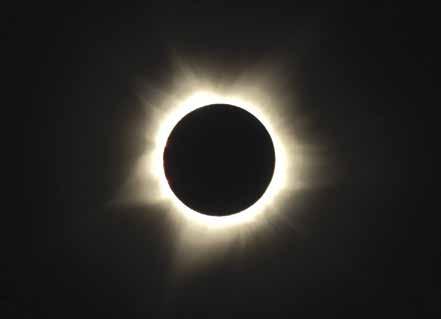
Day turns to night! This isn’t a magic trick, it’s a total solar eclipse! The moon is completely covering the sun, creating a breathtaking sight. Look closely – you can see the sun’s corona, like a faint halo, around the darkness. Even nature pauses during this incredible event, with the tempera-
and insects
On the other hand, crickets that are usually active at night began to chirp during totality. It seems insects that rely on light, or the absence of light, from the sun for their daily routines become confused by this unexpected darkness. This is a fascinating example of how even a small change in the environment can influence animal behavior. Scientists are still uncovering the secrets behind these reactions, and you can be a part of the discovery! NASA’s Eclipse Soundscapes Project needs citizen scientists to help them learn more. Check it out: https://eclipsesoundscapes.org/roles/.
What do other animals do during a total solar eclipse?
Solar eclipses are rare events, so animals haven’t evolved specific behaviors for them. The sudden darkness and temperature drop during totality can be puzzling or aweinspiring. Here are some examples:
Birds: Birders have seen some interesting behaviors including purple martin flocks dropping from the
sky and silently perching on wires and trees during totality. Chimney swifts and swallows also stopped flying and roosted during this time. Doppler radar data supports these observations, showing birds flying lower during totality and returning to the skies as the eclipse ends. Interestingly, nighttime birds like owls and nighthawks become more active during an eclipse – taking flight and giving their usual calls.
Dairy cows: Farmers have noticed that these daytime grazers might return to their barns, seeking shelter.
Whales and dolphins: Sailors have observed that even creatures of the deep may surface, surprised by the change in light.
Humans: With special eclipse glasses, many people safely look up and see the total eclipse, including the corona, the ring of light around the sun. Throughout history, different cultures have had interesting beliefs about eclipses. The ancient Chinese believed a sky dragon devoured the sun, while Vietnamese
legend tells of a giant frog eating the sun. In Navajo culture, an eclipse is a time for rebirth, reflection, and reverence.
How do insects tell day from night?
Unlike us, insects don’t have internal clocks like watches! Instead, they rely on “external cues” like sunlight to know when it’s day or night. Many insects, including bees and cicadas, have special lightsensitive eyes called ocelli found on top of their heads. These tiny eyes act like miniature light detectors, working alongside their larger compound eyes.
During a solar eclipse, when the sky darkens for a few minutes, insects get confused because their ocelli send mixed signals!
Do insects ever get confused because of city lights?
Streetlights and lights on buildings can seemingly turn dark nights into more day time. However, artificial lights can confuse the navigation system of insects. Insects rely on natural light sources such as the sun, moon, stars, and Milky Way to navigate. Scientist recently learned that instead of being attracted to light at night, many night-flying insects are trying to align the light to their back as the natural lights at night would be. Instead of being above them, like the stars or Milky Way, artificial lights are too low and throw them off course. This can be a problem for these small creatures and make it harder for them to find food, mates, and shelter. Remember that most insects are beneficial and are not pests. We can help them by turning off lights at night whenever possible.
Do you have a question or two for Dr. Bug? Send them to ReallT@ Missouri.edu or https://bit.ly/Kids AskDrBug. Please include your name and age.
6 April 2024 | kcgmag.com
TAMRA REALL Horticulture Specialist
Dr. Tamra Reall (@MUExtBugN Garden) is the horticulture specialist for MU Extension in Jackson County. For free, research-based gardening tips, call 816-833-TREE (8733), email mggkc.hotline@gmail.com, or visit www.extension2.missouri.edu.
ture dropping
becoming quiet.
Hello



The Kansas City Gardener | April 2024 7
The temperatures were in the single digits and dipping into the negative numbers in January and as I am writing this article in February the temperatures are in the 50s. Kansas City weather if nothing else is never boring. The fluctuating temperatures is the reason rose growers cover the roses for the winter in the Midwest. If we were in a location that had winters where the snow stayed all winter, we would have natural protection from the snow. Unfortunately, our winters go from the 50s to zero so quickly we must provide protection for the roses.
Midwest temperatures also fluctuate in the Spring. I had the experience of a late freeze in April of 2007 while overseeing the Loose Park Rose Garden. The roses had been cut back and had beautiful shiny new leaves when we had several nights of freezing temperatures. According to the NOAA (National Oceanic and Atmospheric Administration) the April 2007 Cold Wave occurred across much of the central Plains, Midwest and into the Southeast. There was a string of 10 days in a row, from April 4-13, where the high temperatures failed to reach 50 degrees. This broke the previous record for continuous days below 50 degrees in April which was 8 days in a row set back in 1888. Kansas City also experienced a stretch of 6 days with overnight low temperatures dropping below the freezing mark. The average temperature for the month of April was 51.9 degrees, only the 4th time in recorded history where the average April temperature was cooler than the average temperature for March (52.6). We lost several of the roses that year and that is the reason I recommend keeping mulch close to the roses during the spring so it can be quickly put around the base of the rose and lower canes to protect them from a late freeze.
March and April are busy months in the rose garden and prun-

April Rose Report
ing the roses is number one on the list of things to do. I take my cue from the first bloom on the forsythia bush (late March to mid-April) to start pruning my roses. In recent years I have been doing an extensive pruning in the fall and removing all the leaves and dead wood making spring pruning easier. I have a you tube video on my channel that shows this in detail.
Harsh winters can turn canes
black all the way to the mulch pile, if this happens pruning becomes self-explanatory removing the black canes until you get to green canes are all that is necessary. I have had years where the canes look like stubs coming off the rose graft due to the cold winter damage. Remember a rose that looks dead above the mulch pile will almost always be alive under the protection of the mulch pile.
Mild winters when the canes are completely green, give the luxury of choosing 3 – 5 good canes (maybe more canes if it is a large
shrub). New gardeners usually are a bit intimidated with cutting back roses in the spring, but you will not damage a rose by pruning it and if you want a visual class in pruning roses check out my YouTube Channel, Judy Penner and look for the spring pruning video. I prune a very vigorous and overgrown Carefree Beauty rose. This is also a rose you should consider if you like pink roses and a rose that is truly carefree! Please like, share, and subscribe to my channel. There is no cost to subscribe or get the information.
that dogs and all kinds of animals love to eat alfalfa just as much as our soil loves eating (processing) it. Watering the pellets helps them breakdown making them less accessible for animals.
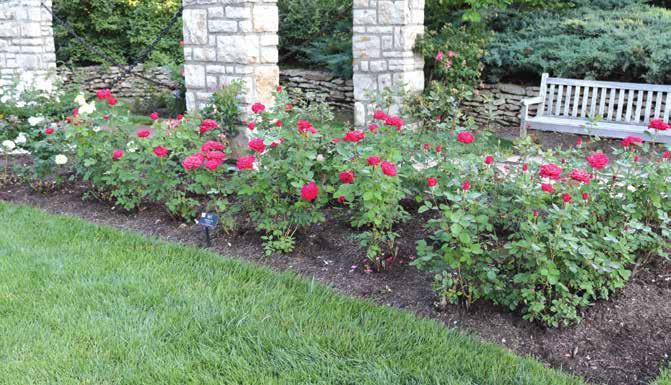
When it comes to fertilizing your roses, I like to feed the rose soil with 2 cups of alfalfa pellets per rose bush and 3 cups for climbers and larger bushes. Alfalfa contains approximately 2% nitrogen, 1% Phosphorus, 2% Potassium, and can be purchased at garden centers or feed stores. I recommend working the pellets into the soil around the rose and watering them in well. I found out the hard way
I also use liquid fertilizers once a month. Roses are heavy feeders and will produce prolific blooms all season with consistent fertilizing and weekly watering. I use natural or organic fertilizers, but chemical fertilizers work if used at the correct application rates. Remember the natural and organic fertilizers feed the soil and the healthier the soil the healthier the plant.
One of the best tools for keeping your roses healthy is a daily walk in the garden monitoring the environment and the roses.
If you have a question, please contact our Ask-a-Rosarian hotline at kcrosehelp@gmail.com. You can expect a response shortly.
Fact sheets on all areas of rose care as well as videos can be found at www.kansascityrosesociety.org.
8 April 2024 | kcgmag.com
This picture was taken in June 2021, my last year working in the Loose Park garden. The rose is Proudland, a hybrid tea rose.
JUDY PENNER
Rose Garden Consultant
Judy Penner is an American Rose Society Consulting Rosarian and Professional Rosarian since 1987. She has a Rose Garden Consulting business and can be contacted at judyssecretgardens@gmail.com.


















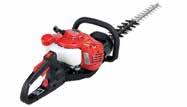



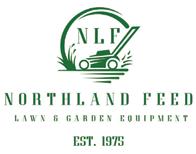
The Kansas City Gardener | April 2024 9 GROWNative! Two FREE events in partnership with the Missouri Department of Conservation, Grow Native!, and Missouri Prairie Foundation SPECIAL EVENT: Go Native Saturday April 27 10:00 AM to 2:00 PM Come celebrate Missouri’s native plants! Join us for a day of learning about the wide variety of native plants that can suit your landscaping needs. Anita B. Gorman Conservation Discovery Center 4750 Troost Ave Kansas City, MO 64110 816-759-7300 Native Plant Sale Saturday April 20 10:00 AM to 2:00 PM The Missouri Prairie Foundation (MPF) is on site for a spring native plant sale. Grow Native! vendors will be on hand with a wide selection of native flowers, grasses, sedges, shrubs and trees for a variety of growing conditions. Scan this QR Code or visit us on the web at mdc.mo.gov/events to find out more about these and other free events! ONE DAY SALE 15% OFF select units STOP IN AND SAVE BIG ON ALL YOUR OUTDOOR POWER EQUIPMENT NEEDS FRIDAY April 19, 9am-6pm www.ECHO-USA.com 4807 N. Brighton, KCMO www.mowerpartskc.com 816-452-8393 Mon.-Fri. 9a-6p • Sat. 9a-1p (closed for lunch 12:45-1:30) ONE DAY SALE Loyalty Program Buy 9 bags of seed & the 10th is FREE! Best Selection Of birding supplies in town! Check Us Out on Facebook & Instagram! Enjoying Nature from the comfort of home! 56 NE Sycamore Street, Lee’s Summit, MO • (816) 272-5878 Locally owned & operated by Drew & Megan Diekmann
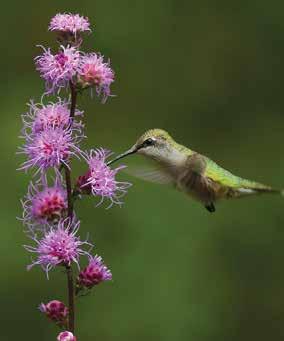
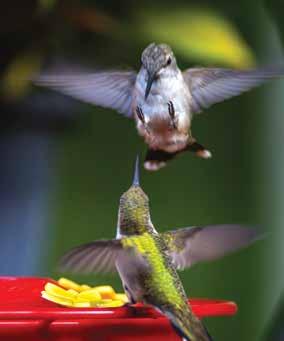

HUMMINGBIRDS
Nectar Sippers and Spider Stalkers
Ruby-throated Hummingbirds are much like spring: they arrive when you least expect them, and bring joy wherever they go!
All migratory birds survive perilous journeys, but a hummingbird’s arrival is miraculous. One thousand miles separate wintering grounds in Central America from summer homes in Missouri. Weighing as much as one penny, hormonedriven birds cover half this distance in a single 18- to 24-hour marathon flight across the Gulf of Mexico, risking their lives for a shortcut.
Tax Day should be renamed “Welcome Hummingbirds Day.” Time for feeders! Conscientious “hummer hosts” use only white sugar and water for nectar (NO coloring). Replace nectar and clean feeders every other day when temperatures exceed 80°F, twice weekly otherwise. Wash feeders with dish soap (don’t forget the feeding ports) and rinse thoroughly. Feeders should feature “ant moats.” Refill these daily as water evaporates quickly. Saucer-shaped feeders help prevent bees from usurping

nectar. Avoid labor-intensive feeder maintenance by planting native flowers to supply nectar from April to October. Red buckeye trees, columbine, and bluebells make excellent spring choices. Coral and yellow honeysuckles (Lonicera sp.), bee balm (Monarda sp.), royal catchfly (Silene regia), and penstemon blooms emerge in summer. Fall favorites include blazing stars (Liatris sp.), cardinal flower (Lobelia cardinalis), and blue sage (Salvia azurea). Nonnatives, like zinnias, cleome, and butterfly bush (Buddleia) are also useful. Keep some plantings near your windows or deck so you can enjoy your visitors!
Feeders and flowers provide a buffet for hungry migrants, but nectar alone isn’t adequate. Did you know that a hummer’s GI tract processes nectar in just 20 minutes? Sugars fuel active days, but fats and protein are required to gain and maintain weight. Recent research revealed that hummingbirds spend more time foraging for insects than visiting flowers! Fortunately, nec-
Enthusiast
tar plants shelter delectable fruit flies, aphids, mites, and their favorite—SPIDERS! Hummers steal extra meals from webs, even at risk of ensnaring themselves. Tree sap (from sapsucker holes) has everything: sugar plus trapped insects.
Males establish territories including elevated perches. Visiting females are treated to acrobatic displays. The male swoops dramatically from his perch and flies forward and backward in wide arcs. Later, he hovers facing her, shuttling left and right, flaring his tail feathers and flaunting his brilliant red throat. If he’s successful, mating is accomplished quickly. The female departs to raise her brood alone. She may produce a second family, often with a different mate. The male entertains as many females as possible, while constantly chasing rivals away.
Both sexes lose up to 25% of their body weight during breeding. By July, they’ll return to feeders for pre-migration feasting. Adult male hummingbirds may depart by early August, quickly followed by females. Lastly, newly fledged
youngsters travel alone to a winter home they’ve never seen; many novice migrants won’t survive their first year.
Ruby-throated hummingbird populations remain stable. However, like all birds, they’re dealing with rapid climate change and habitat loss, so we can’t take them for granted. Shorter, milder winters allow them to migrate north up to 10 days earlier in spring. More hummers now linger on the Gulf Coast all winter, avoiding the dangers of long-distance migration. On the downside, premature arrival may expose them to inclement weather and inadequate food supplies. Declining insect populations mean less food for chicks and higher mortality for all ages.
Hummingbirds are resilient, energetic, and beautiful. Please help them thrive, not only by providing tangible resources, but by reporting your observations to help document their migration dates, nesting activity, and plant preferences. For more information, please see eBird.org and https://JourneyNorth/ hummingbirds.
Elizabeth Stoakes is currently President of Burroughs Audubon Society in Kansas City and has been birding for over 25 years. Please contact BAS via mail@burroughs.org or text/call 816-795-8177 with any birding questions.
10 April 2024 | kcgmag.com
ELIZABETH STOAKES Birding
Photo by Terrence Thompson.
Blazing Star (Liatris) attracts hummers.
Hummers often tussle over food.
Photo by Terrence Thompson.
Photo by Mervin Wallace.
Fall Favorite: Cardinal Flower (Lobelia)
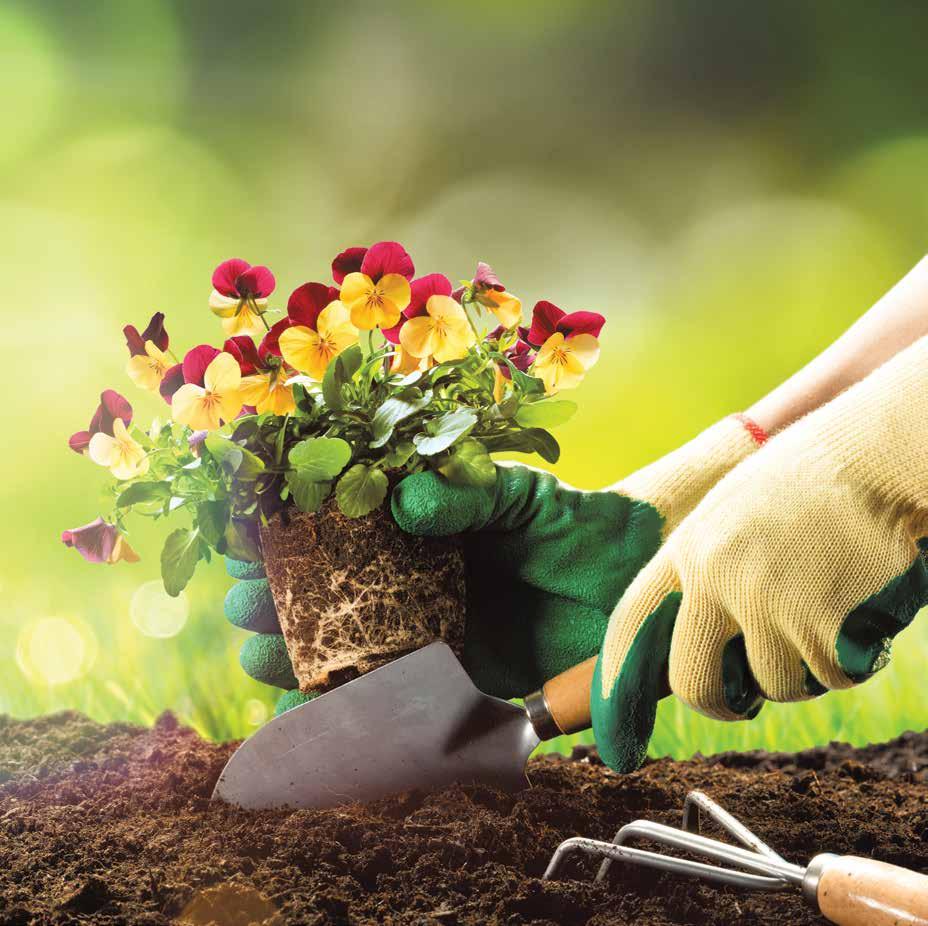


The Kansas City Gardener | April 2024 11 SHOP IN STORE SCAN THIS QR CODE VISIT START SHOPPING TODAY! GARDEN CENTER READY, SET, GROW!
PLANTS ON YOUR PLATE Arugula
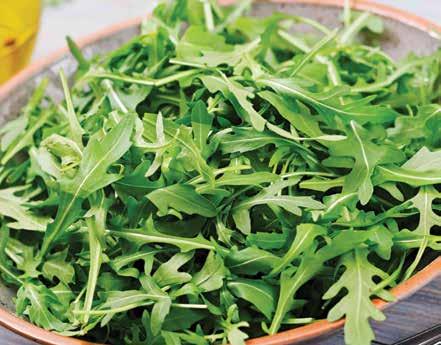
If you have been considering ways to change up your salad, mixing in new and different greens—like arugula—is an easy and fun way to start. Arugula is a spicy green in the Brassicaceae family, that is sometimes referred to as Italian cress. It is a cousin to cruciferous vegetables like broccoli, cauliflower and kale. It is native to the Mediterranean region, where it grows best on dry, disturbed ground. It has been cultivated since at least Roman times, and is still common in Italian cuisine, hence its common alias. The seeds were also thought to be once used in aphrodisiac concoctions.
Arugula is a cool-season crop, grown like most other greens to be used raw in salads or cooked as an accent in a variety of dishes. Although arugula has been around for a long time, it gained popularity in the United States in the 1990s as a trendy leafy green. It is commonly included in spring greens salad mixes. In the U.S., most arugula is commercially grown in California and Arizona, though it can easily be included in an early Midwest garden. Like most tender

greens, arugula is highly perishable and needs to be used within a few days of purchase or harvest. Sealed plastic bags create a moist environment that makes the greens mushy, so keep them in a damp paper towel until ready to eat.
Arugula’s popularity has as much to do with its health benefits as its taste. This delicious green is a nutrient-dense food that is high in fiber and phytochemicals. Like other salad greens, arugula is low in sugar, calories, carbohydrates, and fat. It is high in several vital nutrients including:
Calcium, which is necessary for bone and tooth health, muscle and nerve function, and proper blood clotting.
Potassium, a mineral and an electrolyte that is vital for heart and nerve function and normal muscle contraction.
Folate, a B vitamin that helps support the production of DNA and is particularly important for women who are pregnant or planning to become pregnant, protecting against neural tube defects.
Vitamin C, a powerful antioxidant that helps support the immune
system and is important for tissue health and the absorption of iron from food.
Vitamin K, which helps with blood coagulation. If you use a prescription blood thinner, such as warfarin (Coumadin), discuss your vitamin K intake with your doctor prior to changing your eating habits.
Arugula is delicious as a healthy add-on topping for pizza, nachos, sandwiches, and wraps. It
can also be used as an alternative to basil to make hot or cold pesto. It makes a delicious side salad with nothing more than a drizzle of extra virgin olive oil, salt, and pepper. Arugula’s leaf shape and taste also make it an interesting complement to citrus fruit and berry salad, and makes an excellent base for more substantial salad recipes. The recipe below uses a variety of flavors, colors, and textures, resulting in a delicious and memorable meal.
Arugula Blueberry Salad
MAKES 4 SERVINGS
INGREDIENTS
Vinaigrette
2 tablespoons extra virgin olive oil
2 tablespoons white balsamic (or other) vinegar
1 tablespoon lime juice, freshly squeezed or bottled
1 teaspoon sugar
1/4 teaspoon salt
1/8 teaspoon pepper
Salad
4 cups fresh arugula
1 cup fresh blueberries
1 medium English cucumber, cut into small chunks
1/4 medium red onion, thinly sliced
1/4 cup crumbled reduced-fat Feta cheese
2 tablespoons coarsely chopped walnuts, toasted
4 slices whole grain bread
DIRECTIONS
• In a small bowl whisk together vinaigrette ingredients.
• Cut bread into cubes and toast in a 400 degree oven for 10 minutes or until lightly browned. Set aside.
• In a large bowl mix together all salad ingredients. When ready to serve, add vinaigrette to salad and toss. Add croutons just before serving.
NUTRITION INFORMATION
Calories: 212, Total Fat: 10g, Saturated Fat: 3g, Sodium: 368mg, Carbohydrate: 24g, Fiber: 4g, Protein: 7g
*** For a delicious main dish salad, add 2 cups of diced grilled chicken.
Recipe from USDA Mixing Bowl.
Denise Sullivan is a retired Nutrition and Health Education Specialist, with 38 years of experience in the Missouri, Kansas, and Texas Cooperative Extension Systems.
12 April 2024 | kcgmag.com
DENISE SULLIVAN Nutrition Ninja




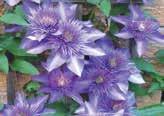
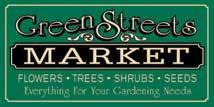




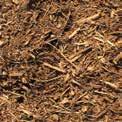


April 20, 10 a.m. to 2 p.m.
Deep Roots Native Plant Sale at Metropolitan Community CollegeLongview; 500 SW Longview Rd, Lee’s Summit 64081. April 27, 10 a.m. to 2 p.m. deeprootskc.org
Shawnee Indian Mission Foundation - Native Plant Sale at 3403 W. 53rd St, Fairway KS 66205. Saturday, April 27, 9 a.m. to 2 p.m. shawneeindianmission.org
Native Plant Sale by Burroughs Audubon at 6212 NW Barry Rd. KC MO 64154. Backyard Bird Center 816-746-1113. Saturday, May 4, 10 a.m. to 2 p.m.
Missouri Prairie Foundation Native Plant Sale at Anita B. Gorman Conservation Discovery Center, 4750 Troost Ave, Kansas City MO 64110. Saturday, May 11, 10 a.m. to 2 p.m.



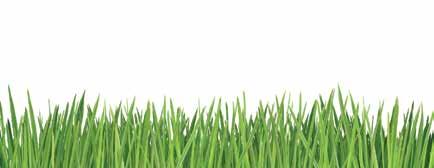
The Kansas City Gardener | April 2024 13 Come see what’s blooming at Enright ... We have everything you need from Azaleas to Zinnias. Enright Gardens No Ordinary Gardening Adventure gorgeous plants, wonderful staff, unique garden store www.enrightgardens.com NOW BLOOMING AT THESE 3 LOCATIONS 2351 N. 400 Rd. • Edgerton, KS • Hours: 9am-6pm, Mon.-Sat. • Sun. noon-4pm 2 miles west of Edgerton on Hwy 56 to County Line, 2 miles north 1/2 west Turner Community Gardens • 55th & Klamm Street • Turner, KS Mon.-Sat. 9am-6pm • Sun. noon-4pm KCMO Farmers Market Location • 3rd & Walnut, Saturday only Stall 50 across (west) from the Arabian Top Soil • Mulch • River Rock • Sand • Gravel Fireplace Materials • New & Used Brick • Pavers 9108 W. 57th Merriam, KS 66203 (1 blk E. of Merriam Dr.) Hrs: Mon.–Fri. 7am–4:30pm • Sat. 8am–12pm 913-432-8092 One free, easy call gets your utility lines marked AND helps protect you from injury and expense. Safe Digging Is No Accident: “Always Call Before You Dig in Kansas” Call 811, 1-800-DIG-SAFE, (800-344-7233) or visit us at www.kansas811.com. Missouri Wildflowers Nursery
fax: 573-496-3003 www.mowildflowers.net mowldflrs@socket.net 9814 Pleasant Hill Rd Jefferson
MO 65109 Meet us at one of these locations in the KC area. Give us your order by Tuesday before a sale, and we will bring it to the location.
573-496-3492,
City
Foundation Native
Sale at
B. Gorman Conservation
Center,
Ave,
Saturday,
Missouri Prairie
Plant
Anita
Discovery
4750 Troost
Kansas City MO 64110.
Great selection of bulk seed • Renee’s Garden, Botanical Interests • Fertilome fertilizers Beautiful spring flowering trees and shrubs Proven Winners annuals and shrubs! Planters • Urns • Garden Accents • Bird Baths Tables and Benches • Fountains • Wind Chimes 112 E. Green St. • Clinton, MO 64735 660-885-3441 • Mon.-Fri. 8-6, Sat. 8-4 125 varieties of Clematis A Gardener’s Destination
UP CLOSE with Drew and Megan Diekmann
RETURN TO NATURE — BACKYARD BIRDING & MORE
Owners/Operators:
Drew and Megan Diekmann
Mission statement:
Bringing people and families together by sharing the love for nature and backyard birding.
Products offered:
Our inventory includes bird feeders, bird seed/ food, bird baths and accessories, outdoor furniture, smokeless firepits, optics (binoculars and spotting scopes), gifts, wind chimes, apparel, and children’s toys and books.
What prompted/inspired you to open
Return to Nature?
Simply put, we wanted to spread our joy of birds and the outdoors with the public. Inspired by doing something that bettered the world around us, we encourage others to leave the cell phones, tablets and other devices behind and ‘Return to Nature.’ Let’s give a little back to mother nature by feeding the birds, helping the pollinators, and simply enjoying the beauty around us, which is all possible from the comfort of our homes, and around the community!
What makes Return to Nature different than other birding stores?
We are the only locally-owned and operated birding store in the area, and are not a franchise. Our store is spacious, well-lit, clean, and we have the best prices around. We also feature locally-made bird houses, candles, and other gifts. We pride ourselves on carrying mostly American-made products, many of which carry lifetime warranties. We also have a seed loyalty program, where customers can buy any 9 bags of seed, and get the 10th one free, with no buy-in or club required. We match our customers’ passion with the joy of birding and share that with our personal experiences and pictures. Current backyard bird pictures are on display in the store, as well as on social media. We genuinely care about our customers, and their families, and even their pets. We always have fresh, quality dog treats, and are a pet-friendly store!
What’s wrong with buying seed from a big box store?
A couple of things: One, it’s highly doubtful that a big box store will come close to the freshness of the seed and food that we carry. Most “big box

seed” is not all-natural, non-GMO, quality seed, and contains lots of fillers that most birds will not eat. Also, there is rarely anyone available at a big box store to ask questions or run ideas by. If we answer your questions, you are more likely to become a happy, successful birder. Parking at our store is always available, with minimal distance to walk, and we gladly load your seed and/ or purchases into your vehicle. Lastly, most big box stores will not remember you, your pets, your spouse, or your current “regular seed” or feeding setup. We always greet customers as they come through the door—something that seems almost rare these days!
Do you offer classes?
We have not yet offered classes, but plan to in the near future, as well as “bird walks” and guest speakers that will come to the store to give presentations. Stay tuned to our social media for announcements and check in monthly with The Kansas City Gardener magazine for updates!
What every birding enthusiast/gardener should know.
Feeding birds isn’t seasonal; it should be done year-round for regular visitors. Keep your feed-
ers clean and your seed dry. Hummingbird feeders need daily cleaning when the temperature is over 90 degrees. Stay away from pesticides and “Mosquito treatment.” Plant native flowers and plants to attract and support pollinators and native birds.
What is your personal favorite outdoor activity?
Birding, of course! (We’re huge bird nerds.)
At the end of the day, how do you spend your free time?
We love to spend time at home with our two cats, relaxing and enjoying the outdoors from our front porch or back patio, especially around our Breeo firepit.
Contact information:
We are located at 56 NE Sycamore Street, Lee’s Summit, MO 64086. Currently, our hours are 10a-5p, Tuesday-Saturday (Closed Sunday & Monday). Phone 816-272-5878 Website is ReturntoNatureLS.com and Facebook at www. facebook.com/ReturntoNatureLS and Instagram at @ReturntoNature_LS. Come visit and take a look around. We look forward to meeting you.
14 April 2024 | kcgmag.com








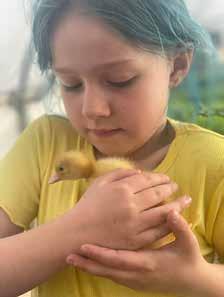

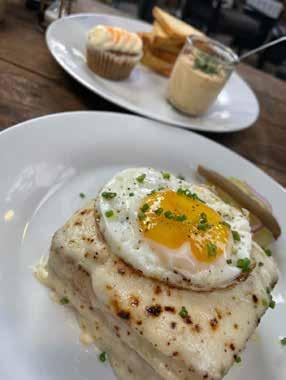

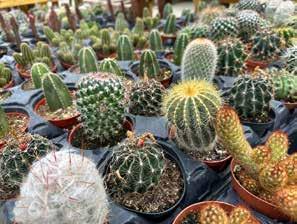

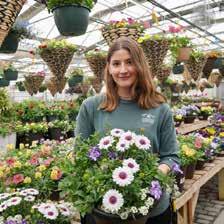

The Kansas City Gardener | April 2024 15 C O L O N I A L G A R D E N S C O M Experience 2 7 6 1 0 E W Y A T T R O A D B L U E S P R I N G S M O 8 1 6 - 2 2 9 - 1 2 7 7 C O L O N I A L G A R D E N S $ 2 0 O F F W I T H P U R C H A S E O F $ 1 0 0 + I N S T O R E Finally! Organic Ingredients that Really Work! For Organic Use OMRI.org Pet Safe When used as directed when used as directed FOR ORGANIC GARDENING Family Owned & Operated • Made in USA www.sierranaturalscience.com *when used as directed. Powerful Pet & People Safe Pesticides & Fungal Controls* Now Available at Suburban Lawn and Garden Green Street Market • Planters Seed Company Ranch Mart Hardware • Larrys Nursery Arnolds Greenhouse Euston Hardware 6955 Tomahawk Rd. Prairie Village, KS 66208 Euston Hardware 453 E. Red Bridge Rd. Kansas City, MO 64131 Packs Hardware 116 US-169 Hwy Smithville, MO 64089 (913) 262-6737 (816) 216-7197 (816) 532-0525 OUR LOCATIONS:
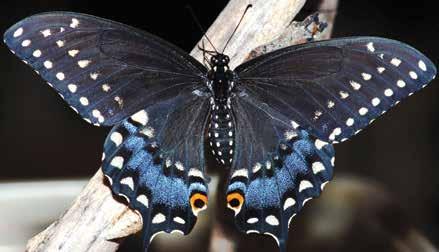
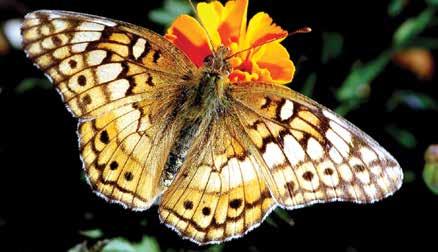
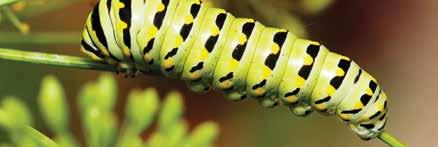
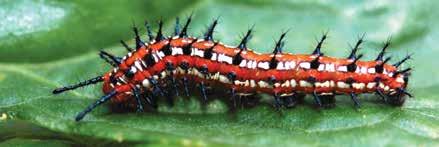
Feeding the Children Butterfly Host Plants: The Secret to Successful Butterfly Gardening
We see butterflies visiting flowers and assume that flowers are a butterfly’s food. Not true! Adult butterflies can’t eat. They don’t even have a mouth! They are simply visiting the nectar pub to sip adult beverages. Butterfly gardening emphasizes caterpillar food plants rather than flowers because only the caterpillar eats and grows. And if you don’t feed the child, there will be no winged adult.
Understanding a Butterfly’s Life
That winged butterfly is only one of their four stages of life, and adults have just one purpose: reproduction. Many insects including butterflies, moths, bees, ants,

beetles and flies live in four stages, called “complete metamorphosis.” Each stage looks differently and has different needs and purposes. A butterfly egg, like a plant’s seed, carries the genetic information to the next generation. The caterpillar does all the eating and stores the nutrients that will transform into the adult’s wings, genitalia and eggs/sperm. Once a caterpillar is full-grown, it transforms into the third stage, the chrysalis, where all the caterpillar’s tissues re-organize through metamorphosis to emerge as an adult butterfly. Sadly, the beautiful adults die after mating in only a week or two. Note: The Monarch’s 4th migrating phase is a wondrous exception because they
delay breeding to migrate south each fall and mate in Mexico. A female may live up to six months before returning to the United States the next spring to lay her precious eggs and die.
Host Plants, the Caterpillars’ Food
By definition, the leaves of a host or caterpillar food plant contain a molecule that prompts a particular butterfly species to lay eggs. Native plants and native butterflies have evolved together over millions of years to create these unique relationships; however, many non-native plants in the host plant’s family may also contain that special molecule. And just being native doesn’t
make a plant a butterfly host. Douglas Tallamy, PhD, author of the best sellers Bringing Nature Home and Nature’s Best Hope, has published research demonstrating that less than 15% of native plants are Lepidopteran (moths and butterflies) caterpillar hosts. Since about 98% of these caterpillars are moth species, only a few native plant species serve as butterfly hosts. Butterflies are very picky! For example, some members of the Carrot/Parsley family contain the unique molecule that triggers Black Swallowtails to lay eggs and their caterpillars to feed. My garden contains both cultivated and native members in this family. I love my native Golden Alexanders for their beauty, but the Black
16 April 2024 | kcgmag.com
LENORA LARSON Butterfly Maven
A Marais des Cygnes Master Gardener, Lenora is a member of the Idalia Butterfly Society and Kansas Native Plant Society. She gardens in the clay soil and cruel winds of Paola, KS. She may be contacted at lenora.longlips@gmail.com.
Female Black Swallowtail
Adult Variegated Fritillary
Variegated Fritillary on Common Violet
Black Swallowtail eating a Dill flower

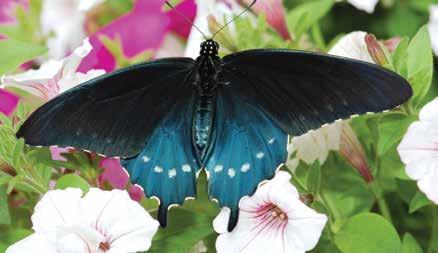




Swallowtails unanimously prefer to oviposit on Parsley, Dill, Fennel and Moon Carrots.
Identifying Host Plants
Butterflies are superb botanists at the molecular level and find their host plants by smell and taste. The olfactory organs on the antennae of a passing female “smell” host plant molecules in the air. She follows the molecular trail to land on the plant, tasting it with chemical receptors on her feet. She will not release an egg unless that unique plant mole-
cule and her foot’s receptor connect like a key in a lock. Every butterfly species has a unique host plant. The Milkweed family hosts Monarchs; the Carrot family hosts Black Swallowtails, the Pea family hosts our six species of Sulphurs (the bright yellow and orange butterflies), etc. Gardeners are familiar with plant families and can apply this concept to learning the butterfly host plants. The accompanying sidebar lists twenty of the area’s common butterflies matched to their caterpillars’ food plants by family. Adding
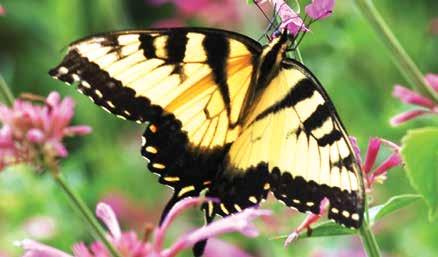

just one new host plant may bring a new butterfly to your yard! Pay attention to your host plants to eventually see the caterpillars. Many of us prefer these charismatic children to their beautiful parents.
Sources of Information
Which native butterflies do you wish to attract? You can find the host plants for your chosen butterflies listed in butterfly field guides. Or Google any butterfly species; the description should include the caterpillar food plant. Conversely,
Google the name of a plant plus the words “butterfly caterpillar” to find out if that plant serves as a food plant. Unfortunately, non-scientific websites may ignore your question and answer for the adult butterflies, using words like “pollinator” or “flowers” or “nectar.” Be alert! Even university.edu websites may wrongly focus on flowers. The best resources are wildlife educational organizations like Monarch Watch, National Wildlife Federation, NABA (North American Butterfly (continued on page 18)
The Kansas City Gardener | April 2024 17
Adult Male Monarch
Male Pipevine Swallowtail
Female Spicebush Swallowtail
Male Eastern Tiger Swallowtail
Spicebush Swallowtail on Spicebush
Tiger Swallowtail on Tulip Tree
Monarch on Common Milkweed
Pipevine Swallowtail on Wooly Pipevine
Feeding the Children
(continued from page 17)
Association), and Xerces Society. Each has an excellent website with information and host plant lists by region. In addition, NABA and Xerces have published butterfly gardening books, available for sale on their websites and on Amazon.
Summary: Buying Host Plants
You can influence which butterflies nectar in your garden by which caterpillar host plants you supply. Another ecological guideline: 90% of insects are host plant specific, so include as many native plants as possible to ensure food for insect-eating birds and other animals. Native plant catalogs and nurseries usually identify their butterfly host plants. Many area native plant sales offer host plants. Monarch Watch will have their annual butterfly plant sale in Lawrence on May 11th. And the Paola Master Gardener Plant Sale, famous for its native plants and the exceptional selection of host and pollinator plants, runs on April 25, 26, and 27. Come see us at 913 South Pearl (the K-State Extension parking lot) in Paola, Kansas.
Case Study: Host Plants for the Giant Swallowtail
There are about 60 resident butterflies in the KC area. About half of these are LBBs (Little brown butterflies) whose caterpillars eat native grasses. A partial list of host plants for 20 of our larger butterflies is presented in the following table. Google the butterfly or the plant for more information and photographs. Butterflies often use multiple members of a given family, so family relationships may be the easiest place for you to start learning the butterfly/host match.

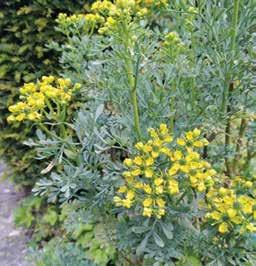

ABOVE: A female Giant Swallowtail shows her 7-inch wingspread as she nectars on Tropical Milkweed, a host plant for Monarchs. The caterpillars (shown inset) are known as Orange Dogs.
A citrus family host for the Giant Swallowtail, “Herb of Grace” Rue, Ruta graveolens has been grown for centuries as an insect repellant and an abortifacient.
With a wingspread of up to 7 inches, Giant Swallowtails are the largest butterfly in North America. Why is this tropical-looking butterfly native to the Midwest? Simple, we have two native citrus trees: Hop Tree, Ptelia trifoliata and Prickly Ash, Zanthoxylum americanum. Herb gardeners may also see the Giants because their caterpillars eat Rue, Ruta graveolens. Who would ever guess that, despite their common names: Rue, Orange and Lemon Trees, Prickly Ash and Hoptree, all belong to the Citrus family? The Giant Swallowtail butterfly knows and she only lays her eggs on Citrus plants. In the south the host plants are Orange, Lime, Lemon and Grapefruit trees. The caterpillars, also known as Orange Dogs, incur the wrath of citrus growers who relentlessly spray insecticides to kill them. Fortunately, in the Midwest the host plants are not eaten by humans so we don’t compete for food and can enjoy this beautiful huge butterfly.
Plan layout so people could cut out and save)
There are about 60 resident bu1erflies in the KC area. About half of these are LBBs (Li1le brown bu1erflies) whose caterpillars eat na@ve grasses A par@al list of host plants for 20 of our larger bu1erflies is presented in the following table. Google the bu1erfly or the plant for more informa@on and photographs. Bu1erflies oGen use mul@ple members of a given family, so family rela@onships may be the easiest place for you to start learning the bu1erfly/host match.
Bu0erfly Host Plant Family Examples
Black Swallowtail
Buckeye
Carrot (Umbellifer)- Apiacea Parsley, Fennel, Golden Alexanders
Figwort- Scrophulariaceae Snapdragons, Plantain, Angelonia
Cabbage White Cabbage/Mustard- Brassica Broccoli, Colewort. Wild Mustards
Common Wood Nymph Grasses -Poaceae Big & Li1le Bluestem
Emperors Hackberry- Cel8s Hackberry Tree
Fri@llaries
Giant Swallowtail
Monarchs
Violets- Viola Common Violet, Bird’s -foot Violet
Citrus- Rutaceae Rue, Hoptree, Prickly Ash, Lemon
Milkweeds- Asclepias Bu1erflyweed, Hairy Balls, Tropical Milkweed, Common Milkweed
Painted Lady Many, incl Ne1les & Mallows Hollyhocks, Ne1le, Thistles, Asters
Pearl Crescent Aster- Asteraceae New England Aster, Fragrant Aster
Pipevine Swallowtail
Pipevine- Aristolochia Best: Aristolochia macrophylla
Red Admiral Ne1les- Ur8caceae S@nging Ne1le, False Ne1le
Red-spo1ed Purple
Cherry- Prunus, Willow- Salix Wild Plum, Weeping & Pussy Willow
Silver-spo1ed Skipper Legume Leguminacea Woodies like Locust & Wisteria
Spicebush Spicebush-Lindera Spicebush & Sassafras
Sulphurs (6 species) Legume- Fabaceae
Tiger Swallowtail
Viceroy
Magnolia, Cherry- Prunus
Senna, Partridge Pea
Tulip Tree, Sweetbay Magnolia
Willow -Salix, Cherry-Prunus Wild Plum, Weeping & Pussy Willow
Zebra Paw Paw- Annonaceae Paw Paw
18 April 2024 | kcgmag.com
LEFT:









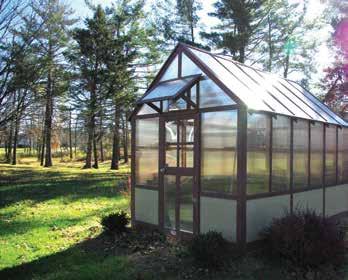

The Kansas City Gardener | April 2024 19 Western Red Cedar Greenhouses with maintenance-free Azek® exterior Available in several sizes frontierfurnishings.com • 618-465-8868 • 101 W. Third St., Alton, IL 62002 BEAUTIFUL • PRACTICAL • FUNCTIONAL 1601 NE Tudor Rd, Lee’s Summit, MO (816) 525-4226
Vegetable Plants, Herbs, Lawn Fertilizers and more. Special on ferti-lome 5-Step Lawn Care Program Shrubs and Trees arriving daily! Mowing • Trimming Planting • Mulching Seeding • Aeration Fertilization • Clean Up
Berberian 913-208-5941 LawnsByBarclay.com
Annuals,
Barclay
Dig it! The Dirt on Site Selection and Planting Fruit Trees in Kansas City
The first Arbor Day in the United States was April 10, 1872. National Arbor Day now is celebrated on the last Friday of April. Since then, many states have instituted their own Arbor Day, one that better corresponds to the appropriate time to plant trees: Texas is the first Friday in November; Georgia the third Friday in February; Missouri the first Friday in April. Kansas sticks to National Arbor Day but may want to consider bumping it up a few weeks *nudge, nudge.* Around Kansas City, we can plant trees from February to early May and October to December.
Amidst the celebration of Arbor Day lies the mission of The Giving Grove, a non-profit organization committed to fostering community orchards and promoting sustainable urban agriculture. Through community engagement, education, and tree planting, local Giving Grove programs, like the one at Kansas City Community Gardens, strive to create productive, beautiful green spaces that provide fresh produce, beautify neighborhoods, strengthen community bonds, and promote environmental awareness.
Planting a tree is an easy task, but it is not a task to be taken lightly. If you are considering planting a bare-root fruit tree this spring, here are some considerations worth taking:
Site Selection: Most fruit trees need full sun (8+ hours) for flower bud development and fruit production. However, not all sun is created equal. For instance, the morning sun can help dry up dew quickly. Lingering dew can lead to leaf and fruit fungal diseases. Other things to consider: squirrel highways and byways, frost pockets, stagnant air, proximity to walnut trees (many fruit plants are sensitive to Juglone in the soil), and overhead/spray ir-




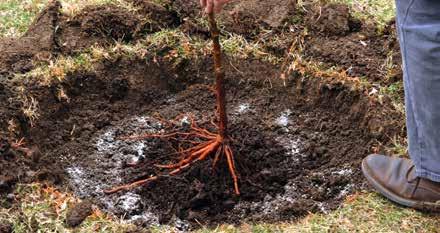
rigation (this type of wetness can cause fungal problems).
Tree Size: Semi-dwarfing rootstock is the most common and best suited for homeowners and will have a spread of 12-15’ and a height of 10-25’.
Soil Health: Most trees pre-
fer well-drained, loamy soil with a pH of 6.5-7.5. Fruit trees do not like wet feet (poorly drained soils), so do not plant them in a low spot in the yard. Consider aeration and adding compost to the entire site if you have a heavy clay content. You may want to get your soil analyzed,
especially if you are investing heavily or you have had nutrient problems in the past.
Now that you have chosen your planting site and tree, it’s time to plant your bare-root tree. Planting a tree involves simple yet essential steps. You don’t need fancy equipment; a round point shovel, sharpshooter, and optional sod shovel will suffice. Below is a simple howto for planting a bare-root tree. For more comprehensive instructions, visit www.kccg.org.
Outline a circle twice the root system’s diameter (24-36” hole for bare-root trees) using chalk or spray paint.
Remove sod if needed, starting from the middle to avoid compaction. Break the soil along the edges to encourage root growth. The depth of the hole should be 8” to 12”.
Create a soil mound in the middle of the hole and place the tree on the mound. Spread roots from the mound, ensuring the graft is at the soil level.
Backfill the hole with the native soil and a small amount of compost (1/10th to 1/3rd the volume of the hole) avoiding clods, and gently work the soil around the roots with your hands. Do not compact soil by stepping on it.
Mulch the site, keeping it shallow near the trunk. (Think donut, not volcano.)
Water with 5 gallons weekly if precipitation is lacking especially in droughty conditions.
Tree planting is not just a onetime event but an ongoing commitment to environmental sustainability and community well-being. With the collective efforts of organizations like Kansas City Community Gardens, The Giving Grove, and neighbors like you, we can create healthier, greener communities for generations to come.
MATT BUNCH | The Giving Grove | SARAH SIKICH
Matt Bunch is The Giving Grove program director for Kansas City Community Gardens and Horticulturist for The Giving Grove’s national network. Contributing to this piece is Sarah Sikich, Marketing & Communications Manager for The Giving Grove. For more information about Kansas City’s Giving Grove program, visit www.kccg.org/giving-grove.

20 April 2024 | kcgmag.com
Proper tree hole: wide, not too deep, with a crumbly edge (not compacted)
Backfill with a mixture of mostly native soil and some compost
Bareroot tree
Tender fibrous roots
Photos courtesy of The Giving Grove.
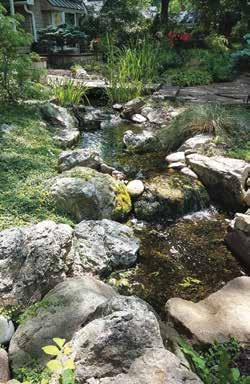















The Kansas City Gardener | April 2024 21 Koi Pond and Water Feature Designs Wendy Hix • 913.481.5416 Tate Foster • 913.406.6804 www.hixandsonaquatics.com New Installations, Remodels Upgrades, Repairs and Maintenance Services April Planting Dates Plant Above-Ground Crops: 9, 10, 13, 14, 20-22 • Plant Root Crops: 1, 2, 5, 6, 23, 24, 28, 29 Transplant: 5, 6, 23, 24 • Plant Flowers: 13, 14, 20-22 • Destroy Weeds: 13, 4, 30 Grass Seeds • Fertilizers • Mulches • Bulbs • Bird Supplies • Pottery Best Quality of “Locally Grown” Bird Seed! Flowers & Vegetable Seed ~ Largest Selection in the Area Time to plant your Garden! Vegetable, Herb, Flower seeds and plants are here! Planters Seed Co. • Since 1924 • Retail • Wholesale Lawn • Garden • Farm 513 Walnut, KCMO • 816-842-3651 Mon-Sat 8am-5pm, Sun 9am-3pm Spring Starts Here! • Annual flowers • Perennials • Vegetable starters • Shrubs & trees • House plants • Large selection of new pottery • Full line of fertilizers 436 W. 85th St., Kansas City, MO 816-444-7661 waldogreenhousekc@gmail.com facebook.com/waldogreenhousekc 7130 Troost, Kansas City, Mo. www.soilservice.com 816-444-3403 Landscape Design, Installation and Maintenance Services From trees and shrubs to perennials, mulch and stone, expert Landscape Designers are ready to help with your next project! Call for an At-Home Consultation. Celebrating 90 years! LAKEVIEW NURSERY & STONE WE DELIVER! CALL TODAY! 816.525.1111 WWW.LAKEVIEWKC.COM 1820 NE COUNTY PARK RD, LEE’S SUMMIT
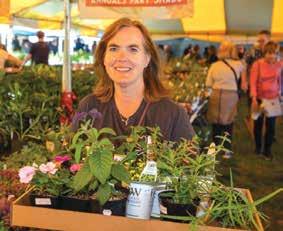

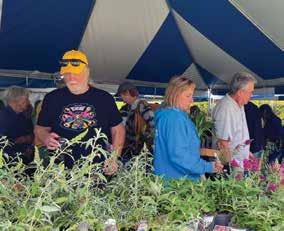

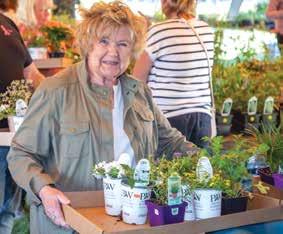
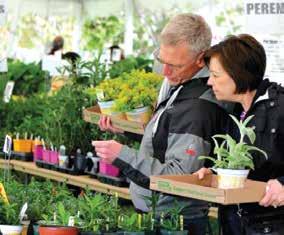
Spring Plant Sale at the Overland Park Arboretum
Spring is springing early this year. Getting us out in our yards and on our patios. Enjoying the warm sunshine, the green of the grass and the chirping of the birds. I bought pansies earlier than I ever have before; I just couldn’t help myself. They make me happy each time I come home, or look out my windows. That’s what plants do…they bring us joy!
Joy, helping nature, and being good stewards are reasons we garden. Each year we strive to make something better, try a new plant. Our Annual Spring Plant Sale at the Overland Park Arboretum & Botanical Gardens is the perfect spot to achieve those needs. Not only do you get beautiful plants, you support the gardens and the mission we embody. Proceeds from the sale go directly to supporting our nonprofit group, Friends of the Arboretum. Your purchases make amazing

things happen in the gardens, from the construction of new greenhouses, to educational programming for the community and so much more.
Our lineup this year includes perennials that are great performers in our Midwest climate, arboretum favorites and new introductions. The USDA updated their hardiness zone map late in 2023, moving us from 6A to 6B. Basically, that means our average lows went up five degrees to -5 to zero degrees.
You can’t miss with Melinis ‘Savannah’ (Ruby Grass), it is one of our most asked about annuals. It is grown best in full sun. Ruby grass has beautiful, slender blue green blades with dainty pink blooms that arrive in mid to late summer. They truly sparkle in the sun. I personally love them tucked in containers or planted in drifts.
Our shrub selections this year offer tried and true choices like
Panicle Hydrangeas, Viburnums, ‘Oso Easy’ Roses, and Spirea. We are excited about Symphoricarpos ‘Proud Berry’ (Coral Berry). I was drawn to its clusters of bubblegum pink berries and moderate size (3-4 feet tall). It should add a touch of pink in the fall landscape.
We also have a wide selection of herbs for your culinary adventures. This year we are going to have a thornless blackberry, Rubus ‘Taste of Heaven’. It gets three to five feet tall and needs full sun. The berries are superbly sweet, and fruiting occurs after the second year of growth.
Shade perennials are always a hot item. We are going to have a fantastic selection of Hellebores, Hostas, Ferns, Carex & Heuchera. A few fun things to try are Epimedium (Barrenwort), Mertensia (Bluebells), Chelone (Turtlehead). Don’t be afraid…they are low
maintenance and tough!
Thursday, April 25 is our Friends of the Arboretum Members-Only Pre-Sale Event from 2pm to 8pm. For the best selection, that is the night to put on your calendar! You can swing by, buy some plants, walk the gardens and have a cocktail on the Longhouse Visitors Center patio (available for purchase). Friday, April 26 at 9am our sale will open to the general public. Admission to the gardens is not necessary to shop, but we hope you will come inside and see all of the new things we have growing and going on in 2024. The sale will run all weekend so plenty of time to get out and shop. Visit our website at www.opabg.org to learn more and explore the full plant sale list.
We look forward to seeing you and bringing a little extra joy to your landscape this spring. Happy gardening!
22 April 2024 | kcgmag.com
Anne Wildeboor is long-time Horticulturist at the Overland Park Arboretum & Botanical Gardens.
ANNE WILDEBOOR Horticulturist
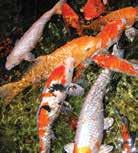
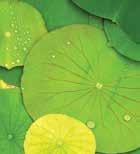














The Kansas City Gardener | April 2024 23 NOW AVAILABLE AT: Jacksons Greenhouse & Garden Center, Topeka v Doctors At the Lake, Lake of the Ozarks v Manns Lawn & Landscape, St. Joe v Gronis Hardware and Seed, Leavenworth v Clinton Parkway Nursery, Lawrence v Barnes Greenhouses, Trenton, MO v Soil Service Gdn. Center, Kansas City, MO v Loma Vista North, Kansas City, MO v Skinner Garden Store, Topeka v Full Features Nursery, Smithville v Springtime Garden Center, Lee’s Summit v Heartland Nursery, Kansas City, MO v Planter’s Seed, Kansas City, MO v Penrod’s Greenhouse, Kearney v North Star Garden Center, Liberty v Grimm’s Gardens, Atchison v Moffet Nursery, St. Joe v Suburban Lawn & Garden, Kansas City, MO Rid Your Lawn OF WEEDS with ferti•lome RAPID WEED CONTROL Works in as little as 24 hours. Dries in 3 hours & is reseedable in 3 weeks. Great for harder to kill weeds like henbit, clover, thistle, dandelions, wild violet & many more.This is the BEST weed killer available and IT WON’T DAMAGE YOUR LAWN! www.fertilome.com WEED FREE ZONE New size! 1 gal. ready to use BFG is the Leader in Green Industry Distribution 816-842-5012 • pondskc.com 1557 Swift Ave., KCMO Come see us first for your pond liner needs. Great prices for both hobbyists and installers. THE METRO’S EXCLUSIVE POND RETAILER See our Facebook page for current hours. Friendly personable knowledgeable service! Fish and Pond Supplies for all your water garden needs! SCHEDULING pond cleanings and spring openings NOW. reenhouse&More! It’s a new season with new ownership/managementand a renewed commitment to excellent customer service! G - follow us on facebook for all the latest news and specials! 1430 Hwy. 58, LeRoy KS 66857 arnoldsgreenhouse.com info@arnoldsgreenhouse.com Sunday 1 - 5 pm (Closed March 31st - Happy Easter!)

The idea of No-Mow April or No-Mow May has taken off in many communities across the country. The theory is to give lawns with native plants like spring beauty and common violet, as well as non-native, but insectfriendly non-natives like clover a chance to bloom, precisely when early-emerging native bees and wasps make their spring appearance. These hungry insects need an instant source of food—nectar and pollen—in order to make it through another season. If nothing’s blooming where and when they emerge, they starve. Lack of habitat (and thus, food sources) is a significant reason why bees are declining nationwide.
But my lawn has no blooming plants because the previous owner suppressed them. Up and down my street and throughout the community, homeowners battle anything other than turf grass in their lawns because collectively, in our society, lawn equals turf grass. The presence of anything other than turf grass in lawns, in many communities, implies neglect.
Perhaps homeowners don’t understand that other plants can be part of a lawn, and that they are useful, providing food for hungry bees and other pollinators. Or that neighborhoods with lawns that include clover and dandelions have more bees. Perhaps they think that anything other than grass in a lawn diminishes property values, or maybe they are just following their neighbors’ lead. Are they giving turf companies too much leeway and not enough scrutiny?
I think there is room for another perspective—where lawns of only turf grass are considered neglectful, and where flowers are a logical and attractive component of lawns.
Back to my yard. “No-Mow April” and “No-Mow May” make no sense for me, for a couple of reasons. First, if a lawn is only turf grass, not mowing it for a month

Reimagining Lawns

is not going to help pollinating insects. I need to diversify the lawn with short-statured blooming plants like spring beauty before I can successfully feed bees. There are a handful of violets coming up by the sidewalk, but not enough to stop cutting the grass. There are four or five little clumps of clover in the strip between the sidewalk and street that I mowed around last spring. Hopefully, they all will spread this season.
Second, there is the question of how much lawn I should have. I’ll keep most of it because I don’t have enough time to convert it all at once to garden beds, nor maintain all of the beds at once. Also, I’ve seen too many no-lawn gardens disappear when the property changes hands. My long-term goal for my home landscaping is 50% lawn and 50% native landscape plants. According to research by Minnesota landscape architect Fred Rozumalski, that is the lawn-to-garden bed tolerance
threshold for most homeowners. My plan is to remove small portions of lawn every year to plant new trees, shrubs, and expand beds, filling them with native plants. I doubt this transition will come as a shock to the neighborhood, because it will take several years to unfold.
Third, what about this notion of letting the grass grow for all of April (or May, if you live in northern states), then chopping it down all at once? It sounds like a maintenance nightmare, come the end of April (or May), not to mention a hard blow to the turf grass itself. My assumption is that if you want some lawn, you will want it to look well maintained. A good way to manage this is to slowly trim back the lawn at the end of April with a string trimmer. Trim one-third of the lawn height back every week until you get back to a normal mow height.
What’s a normal lawn height? I cut the grass as high as my quiet
Ryobi electric mower will allow (about 4 inches). Also, I aim for longer intervals between mowings (about every 10 days for my lawn).
(Keep in mind that every lawn is different, and grass grows quicker in the spring and fall than in summer.) The goal is to mow high and less frequently to give plants like clover enough time to bloom between mowings.
Lastly, when I get to the point when my lawn is brimming with blooming plants and buzzing with a symphony of insect pollinators, I won’t celebrate only in April. I will support blooming plants in my lawn year-round. I’ll jump for joy when I get butterfly violet (Viola sororia), prairie pussy toes (Antennaria neglecta), strawberry (Fragaria virginiana), lyre-leaf sage (Salvia lyrata), yarrow (Achillea millefium), spring beauty (Claytonia virginica), hairy grama grass (Bouteloua hirsuta) and various low-growing sedges (Carex jamesii, C. socialis and C. pennsylvanica), established in my lawn. At this point, the lawn will no longer be merely lawn, it will be something else altogether, perhaps something more like a prairie.
I’ll encourage the summerblooming glade onion (Allium stellatum). And I’ll harvest dandelion, strawberry, clover, and violet greens for my salads, once I’ve lived here a few more years, allowing time for any presumed, former lawn chemicals to dissipate. Until that day, I’ll mow around patches of blooming plants in the lawn, I’ll sprinkle their seeds around the yard, and continue to quietly cut the grass on high and with less frequency to give the lawn flowers more time to bloom and feed the bees. Heck, I may even find bigger wheels for my lawnmower so I can cut the grass even higher. And surely, I will welcome lawn blooms in from wherever they come, as long as they aren’t invasive species! Happy lawn party, ya’ll!
Scott Woodbury was the horticulturist at Shaw Nature Reserve for 30 years and stepped down from that position in June 2022. He continues to work on contract for Shaw Nature Reserve to carry out native landscaping education and has launched his own business called Cacalia: Native Garden Design and Wilding. Find suppliers of native plants, seeds, and services at the Grow Native! Resource Guide: www.moprairie.org.
24 April 2024 | kcgmag.com
SCOTT WOODBURY Horticulturist
Photo by James Faupel.
Reimagine a lawn filled with spring beauty, violets, and dandelion that will support hungry insects searching for instant food.
Be a Part of Something Blooming: Become an Extension Master Gardener!
Do you love gardening and want to share your passion with others? Become an Extension Master Gardener and join a vibrant community dedicated to learning and teaching the best practices in horticulture.
The MU Extension Master Gardener program offers:
• In-depth training: Gain knowledge from MU Extension experts through a 16-week course covering various aspects of gardening, from soil health to plant science.
• Flexible learning: Attend online sessions on Thursdays (1:304:30 PM) starting August 7th, with optional in-person field trips for hands-on experience.
• Make a difference: Volunteer your newfound expertise on exciting local projects like community gardens, children’s programs, and the MGGKC Gardening Hotline, helping others become better gardeners.
• Grow as a gardener: Gain ongoing support and learning opportunities through continued education and a network of passionate individuals.
Limited spots available! Apply by August 2nd.
Cost: $200 (scholarships available)
More information: http://www.mggkc.org/about-us/become-amaster-gardener/ or contact Tamra Reall (ReallT@Missouri.edu)
Don’t miss this chance to cultivate your knowledge and help your community bloom!





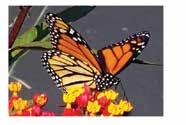


The Kansas City Gardener | April 2024 25 Paola Plant Sale • April 25, 26, & 27 2024 Thursday 9:00 - 5:00 • Friday 9:00 - 6:00 • Saturday 9:00 - 1:00 Pesticide-free, Locally Grown! More Butterfly Host Plants than ever! Native Plants Pollinator Plants Herbs Annuals Perennials Veggies Succulents Hanging Baskets Trees Hypertufa Gifts! Master Gardener Marais de Cygnes District Sponsored by: 913 N. Pearl, Paola, KS, 66071 The sale will be held in the parking lot of the Extension Offices located at 913 N. Pearl, (Old KC Road) Paola, KS Cash, Credit Cards & Checks Accepted FREE Gardening Book Exchange! Bring some, take some! ww AQUATIC PLANTS MARGINALS, LILIES, AND LOTUS POND AND LAKE MANAGEMENT PRODUCTS DIY POND SUPPLIES PUMPS, LINER, AND MORE GOLDFISH AND KOI PLEASE CALL TO CONFIRM PLANT AND FISH AVAILABILITY Retail Opens April 13th Store and Office Hours: Tue-Sat 9AM-4PM 913-837-3510 FOLLOW US 4385 W. 247TH ST., LOUISBURG, KS 66053 WWW.SWANSWATERGARDENS.COM SERVICES • KOI POND AND WATER FEATURE INSTALLATION • SERVICE CALLS: LEAK DIAGNOSIS, LIGHTING, PUMP AND AERATION INSTALL • LANDSCAPE LIGHTING: AMP LIFETIME FIXTURES AND TRANSFORMERS • HARDSCAPES: PATIOS, WALLS, FIREPITS, DECKS, AND OUTDOOR LIVING • CLEANOUT AND MAINTENANCE PROGRAMS • LARGE POND AND LAKE MANAGEMENT
Clueless Cultivator
A Garden Guide For Beginners, By Beginners
My great-grandmother kept a strawberry patch in Rice County, Kansas. I still remember that garden: I was amazed by the bright, otherworldly red of the ripe berries and the aroma of newly-turned soil. I recall I knelt in the dirt and studied the tiny, fascinating buds. Later, my parents kept vegetable gardens and gorgeous flower beds, but that strawberry patch is where I first learned to love growing things.
My husband Scott and I share the aspiration to grow a garden. For years, we’ve dreamed of fresh produce on the table, and nurturing our patch of Earth. It wasn’t until this year we could make it a reality. Last September we moved into a house with a raised bed in a sunny spot of the backyard. At last, we’re going to be gardeners!
Just one problem: we don’t know where to start! There’s a lot of information online, but it’s overwhelming to find the best advice specific to Kansas. Luckily, a friend pointed me to the Kansas Garden Guide from K-State, a marvelous, 200+ page manual containing advice, practical guidance, and even suggestions for making garden maintenance a family affair. Here’s a summary of what we’ve learned so far!
Step One: Select and Prepare the Site
The most important considerations when choosing your garden site are space, sun, soil composition, and water. We’re fortunate our yard has a large raised bed, situated in a sunny, well-drained spot. There are dozens of useful guides and videos online to help you build a raised bed. While it requires planning, budgeting, and basic carpentry knowhow, the benefits to a raised bed are having better control over soil composition and moisture content.
When we moved in, the raised


bed soil was dense, dry, and rocky. There were no earthworms, which meant we’d need to enrich the soil.
Scott and I chose an easy method I learned as a girl: we kept a compost bowl on the kitchen counter for things like orange peels, coffee grinds, and used tea leaves (but never animal products). We’d bury those scraps in the raised bed, then soak the area thoroughly. We cleared sticks and rocks as we went. After about eight weeks, the soil was black and loamy, and earthworms abounded. We took that as a sign that we were doing something right. If the worms thought our bed made a nice home, surely a pepper or a potato might, too. Before winter, we covered the soil in mulch to preserve it and prevent weeds in the spring.
Step Two: Plan, Sketch, and Schedule
Our garden will grow foods we eat nearly every day: onions, peppers, potatoes, peas, cucumbers, and tomatoes. We used the Square-Foot Method to plan the space, which al-
ALISHA GALLOWAY
Aspiring Gardener

lows for higher yields from a small footprint. Our 8’x4’ bed subdivides into 32 square plots. Plant size determines how many you can grow in a single plot. Tomato plants require one full square; smaller plants can thrive closer together. It’s worth investigating the particular species you’re growing to give your plants adequate spacing.
Next, we looked at ideal planting times. Peas and potatoes can be planted in March, whereas tomatoes, peppers, and cucumbers want to be planted in May. One wonderful tip I gleaned from the Garden Guide is to stagger the planting of a particular crop over several days, so that the produce can be harvested in a rolling wave, rather than all at once. Around the time this publication comes out, we’ll be putting in the last of the potatoes; a few weeks after that we’ll start the summer crops. Staggering and scheduling ahead will (hopefully) keep the daily workload manageable.
The best advice I’ve received came from my dear friend Angela,
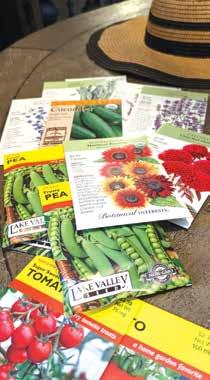
who said to keep a “Garden Diary,” tracking what we planted, where, and when. This will help us track what thrived, what failed, growing times, and yields. Next year, we’ll plan our garden based on lessons learned this year, as well as rotate the crops to avoid soil depletion.
Step Three: Plant!
It’s early March as I write this, and there’s one step left to prepare our soil for maximum fecundity. This weekend, we’ll visit a nearby garden center and pick up a premixed compost to till into the soil we’ve enriched. We’ll also make our final decisions about which seeds and seedlings to bring home.
As the trees begin to bud and squirrels emerge from their dens, the final pieces of our first garden will fall into place. Here’s hoping! My best wishes to any other first-time cultivators who read this. I hope you found it helpful. We can’t predict if our efforts will succeed. All we can do is trust the seeds we’re planting.
26 April 2024 | kcgmag.com
Alisha Diane Galloway grew up on the prairie in central Kansas and graduated from KU with a degree in political science. She lives with her husband, Scott, and their sweet AmStaff, Everett, in the Greenbrier neighborhood of Overland Park.


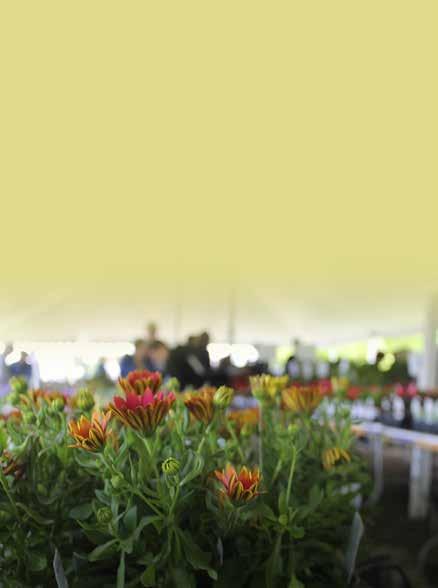










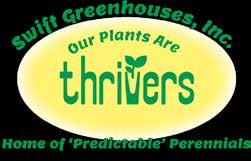




The Kansas City Gardener | April 2024 27 Dianthus Coronet White Purple Eye Monarda Pocahontas Red Rose Veronica Aztec Gold Chrysanthemum Igloo Cool Lewisia Elise Gold Dianthus Rock Ruby Nepeta Limelight Aquilegia Kirigami Rose and Pink Delphinium Guardian Blue Discover the Best New Perennials at a great price! Available early to mid-April in most locations. Bellis Bam Bam Red Lily Asiatic Matrix Orange Herb Mint Mojito Hardy! 3” Blooms! Look for the 4” purple pots at these locations: Rose, Miniature Parade Petula 10 Colors! • Creekside Market • Euston Hardware • Grass Pad • Larry’s Nursery • Louisburg Nursery • Pack’s Hardware • Soil Service • Suburban Lawn & Garden • Water’s Hardware • Westlake ACE Hardware • Plus Other Local, Independent Garden Centers Your Gard en Source Source 816-483-0908 | missouriorganic.com Raised Beds ~ Backyard Gardens ~ Landscaping Top Soils • Garden Soil • Raised Bed Soil • Pulverized Top Soil • Custom Soil Mixes • Green Roof Soil Blends • Rain Garden Soil Blends Compost • NatureWiseTM • Green FrontierTM • Composted Forest Products • Composted Pine Fines Services • Sudden Gardens Consultation • Soil, Compost and Mulch Delivery and Installation Soil Amendments • Growing MOR Nutrient PackTM • Soil RestorationTM
JustCharTM Mulch • Premium I • Colored Mulches (red, brown & black) • Cedar • Hardwood Chips • Erosion Stabilization Introducing Our New Growing MOR Nutrient Pack! Nutritionally-dense premium plant food with biochar, locally-sourced trace minerals and mycorrhizae–everything your plants need to thrive all year long! You’ll find all of our quality products in bulk or bags at all of our locations. Also look for our bagged mulch at Sutherland’s Lumber. Add fresh appeal to your landscape this spring! Consult with our gardening experts and shop over 200+ unique plant varieties, where your purchases directly support the future of the Overland Park Arboretum & Botanical Gardens.
•
Upcoming Garden Events
CLUB MEETINGS
Garden Club of Shawnee
Thurs, Apr 4, 7p; at Shawnee Town 1927 Town Hall, 11600 Johnson Dr, Shawnee, KS. “Designing a Native Garden” presented by K-State Extension Master Gardener Mae Christenson. As always, we will serve drinks and snacks, and great door prizes will be given away. Visitors are always welcome! Please visit our web site gardenclubofshawnee.org and our Facebook page for more information.
Kansas City Cactus and Succulent Society
Sun, Apr 21, 1:30-3:30p; at Trailside Center, 9901 Holmes Rd, Kansas City, MO. Join us for a roundtable discussion on “Moving Plants Outdoors and Early Season Bug Management.” As we begin to transition our plants outside, how do we know where to best place them? Do plants require shady locations, a few hours of morning sun, or several hours of direct sun? We’ll hear from avid growers and share everyone’s plans for keeping our plants healthy from pesky insects and critters. Learn from experienced hobbyists and share your own thoughts. Feel free to bring a plant you enjoy outdoors and that does well for you. Refreshments will be served and we invite anyone to attend.
Leavenworth County Master Gardeners
Wed, Apr 10, 11a; at Riverfront Community Center, 123 Esplanade St, Leavenworth, KS 66048. Our speaker is Linda Suttlehan, owner of Bramble Rose Farm in Basehor KS. Come and hear how she and her husband started Bramble Rose Farm. She will discuss their gardening techniques; vegetables and fruits they like to grow and how they incorporated their daughters into the farm business. She will share the successes and failures they have had over the last 9 years. Linda will also talk about her value added products and where they can be purchased. The meeting is free. Visitors are welcome. For more information contact the Leavenworth County Extension office at 913364-5700.
Leawood Garden Club
Tues, Apr 23, 10:30a; at Cure of Ars Catholic Church, 9401 Mission Rd, Leawood, KS 66206. “Seed Saving – The Pros and Cons.” Are you thinking about saving seeds from this year’s garden? This presentation will share the pros and cons to help you decide if seed saving is for you. Speaker is Sherri Carter. Sherri Carter became an Extension Master Gardener in 2015 and received Advanced Master Gardener Certification in 2021. In MGGKC, she is currently MGGKC Vice President and Past Chair of the Membership Committee. Her projects include Speakers Bureau, Video Production Team and Blue Springs Historical Museum Historical Garden Committee. At home, her garden focus is shade gardens and organic vegetable gardening using raised beds.
MoKan Daylily Club
Sat, Apr 6; at Asbury United Methodist Church, 5400 W 75th St, Prairie Village. The meeting starts at 10:30a with a meet and greet, followed by a pot luck lunch, presentation and short business meeting. The guest speaker is Bobby Scott, a daylily hybridizer from central Oklahoma. Bobby, with his father Bob Scott Sr, operate Topgun Daylilies, and is sure to present an interesting overview of their hybridizing program. Guests are welcome to attend. Questions about the club or meeting
can be emailed to MoKanDaylilySocietyADSR11@gmail.com.
Olathe Garden & Civic Club
Tues, Apr 16, 1-2:30p, at Grace Church, 11485 S Ridgeview Rd, Olathe, KS. *Free to attend and open to the public, club membership not required.* Please join us for our monthly club meeting and annual plant sale preparation discussion. Our annual plant sale is our only fundraiser that supports all our philanthropic efforts and charitable donations in the local community. Plant donations are always needed (perennials & annuals), in addition to help with perennial digging, dividing, and potting up. Please join us if you’d like more information about how you can help!
Raytown Garden Club
Tues, Apr 2, 10a; at Connection Point Church, Raytown, MO. Program will be “Rain Gardens Improve the Well-being of our Earth” presented by Pete Loughlin, Professional Landscape Architect. Guests are always welcome. For more information please check out our Facebook page: https://www.facebook.com/RaytownGardenClub
Greater Kansas City Water Garden Society
Tues, Apr 16; doors open at 5:30p for snacks and socializing. Announcements and the business portion of the meeting begins at 6:30p. Presentation will follow at about 7p at Our Lady of Sorrows Catholic Church, 2552 Gillham Rd, Kansas City, MO 64108. Spring fever is in the air. Bob Schmuck is our featured speaker and gardener extraordinaire. Bob and Frances’s yard has been featured on the cover of magazines and is a destination for plant lovers everywhere. He will begin the evening with a little 1,2,3 refresher on opening your pond with some special tips for everyone. Soil mixtures for your plants is a passionate topic for Bob. He will be sharing what he considers key ingredients for distinct types of plants along with types of fertilizers to use. The timing of these applications is critical for success. Learn some secrets from a veteran gardener. Visit us on Facebook or our website kcwatergardens.com
FESTIVALS | SHOWS | SALES
Orchid Delirium
Powell Gardens reopened to the public March 1 after a two-month respite. Orchid Delirium is scheduled March 1 through April 14. For more info, visit PowellGardens.org.
Eat Local & Organic Expo
Sat, Apr 6, 9a-3p; at Johnson County Community College. Free admission, Free Parking. Kick off farmers market season. Shop with more than 30 KC Food Circle™ farmers who pledge to meet high standards for growing plants and mushrooms, beekeeping and raising animals. Attendees can talk directly with farmers as they sign up for weekly farm shares, buy transplants for their gardens, and get the freshest early spring products for their dinner tables. eatlocalexpokc.com. The Expo was created to help KC Food Circle farmers get a boost of income at the start of farmers market season. Here are the pledges farmers agree to so consumers can shop with confidence https://www.kchealthykids.org/farmerspledges.html
Habitat Garden Tour
Sat, Apr 13, Merriam. Deep Roots announces Habitat Gardens, a new program that invites the public to three local residential native plant gardens every month. Many Kansas Citians are seeking to grow native plants due to concerns about climate change, habitat loss, and the decimation of bird and insect populations. Their efforts, however, may be stymied by challenges like which native plants to choose and where to find them. (Native plants are unavailable at box stores and conventional garden centers.) With Habitat Garden Tours, aspiring wildlife gardeners can visit private native gardens grown by everyday people, in yards much like their own. Friendly garden hosts and other native gardeners will be on hand to answer questions and offer information, plant lists and helpful resources. REGISTRATION: https://www.eventbrite.com/e/ habitat-garden-tours-tickets-855388408757. For more information sign up for The Pollinator, the free Deep Roots e-newsletter.
Annual Orchid Auction and Sale
Sun, Apr 14, 2-4 p; at Merriam Community Center, a fundraiser for the Orchid Society of Greater Kansas City. Wide variety of orchids in flower in a live auction, along with table sales of orchids starting at $5. Free admission and open to the public. www.osgkc.org and on Facebook.
Lee’s Summit Farmer’s Market
Sat, Apr 20, 8a-noon; at Public Parking Lot at corner of Second and Douglas Streets, Lee’s Summit, MO. Come visit the outdoor Farmer’s Market, sponsored by Downtown Lee’s Summit Main Street, Inc. Local growers and artisans offer garden-fresh produce and products for the community. The Master Gardeners of Greater Kansas City will be on hand to celebrate Earth Day with research-based information, a Missouri native plant seed bomb demonstration, and a children’s activity teaching how plants are pollinated, and how Missouri native plants provide food and shelter for butterflies, birds, and beneficial insects. Free to the public.
Earth Day Celebration
Sat, Apr 20, 10a-2p; at Lakeside Nature Center, 4701 East Gregory Blvd, Kansas City, MO 64132. Lakeside Nature Center will celebrate Earth Day with information about the wildlife of Swope Park, learning about preservation while exploring the forest, pond, and marsh around the property, and making wildflower or milkweed seed balls. Master Gardeners of Greater Kansas City Children’s Program will be presenting “What’s in a Seed.” Children will learn about the anatomy of a seed by dissection and observation. They will also discover the ways that seeds are dispersed, and why seeds are an important food source. This event is free to the public, all ages welcome. For more information visit https://lakesidenaturecenter. org/event/earth-day-activities/ or https://extension.missouri.edu/events/extension-mastergardeners-at-earth-day-celebration.
Native Plant Sale
Sat, Apr 20, 10a-2p; at Anita B Gorman Conservation Discovery Center, 4750 Troost Ave, Kansas City, MO. Presented by GrowNative (www.grownative.org) and Missouri Prairie Foundation (www.moprairie.org).
Paola Spring Plant Sale
Apr 25, 26, 27; in the parking lot at the K-State Extension Office, 913 N Pearl (Old KC Road),
Paola, KS. Thurs 9a to 5p, Fri 9a to 6p, and Sat 9a to 1p. The sale will feature pesticide-free locally grown plants. In addition to the usual selection of butterfly host plants, pollinator flowers and native perennials, there will be ornamental annuals, perennials, herbs, succulents, hanging baskets, trees and veggies. Extension Master Gardeners, including butterfly expert Lenora Larson, will be on hand to assist shoppers throughout the sale. Credit Cards welcome! More info at www.maraisdescygnes.ksu.edu. Follow us on Facebook at www.facebook.com/mdcemg or call the office: 913-294-4306.
Raytown Garden Club Plant Sale
Sat, Apr 27, 8a-noon (or until plants are sold out); The club will celebrate Earth Day at Cave Spring Interpretive Center, 8701 E Gregory Blvd. We will have a sale of properly named plants and members will be available to answer questions from the public.
Northwest Missouri Master Gardener Plant Sale
Fri, Apr 26, 8a-4p and Sat, Apr 27, 8a-2p; at Missouri Western University, St Joseph at 4125 Mitchell Ave. The sale will feature many unusual varieties of tomatoes, peppers and eggplants. We will also have lots of herbs and milkweed. Master Gardeners will be available to answer questions and help with purchases. Cash or check only please.
Moonlight On the Veranda
Fri, Apr 26, 5-8p; at Greenwood Vintage Market, 502 W Main St, Greenwood, MO 64034 (Lower Level). $10, Advance tickets required. A garden filled, limited entry event and first dibs on all the wonderful decor, furniture, beautiful plants and more before the general public. All tickets come with a gift bag and entry into a grand prize giveaway. Ticket sales through Apr 21 unless sold out. For tickets, go to facebook.com/GreenwoodVintageMarket/ events/, the link to the tickets is in the event.
On the Veranda Garden Show
Sat, Apr 27, 9a-3p; at Greenwood Vintage Market (Lower Level) Free Admission: A show for garden lovers. Come shop wonderful garden decor, outdoor furniture, plants and more! 816-537-7172
Native Plant Sale
Sat, Apr 27, 8a-noon; at Lenexa Farmers Market, 17201 W. 87th St. Pkwy., Lenexa, KS 66219. Discover a vibrant variety of landscaping options. Browse grasses, flowers, and other plants from local vendors. For more information, lenexa.com/farmersmarket.
Arrow Rock Birds, Bees, and Blooms Festival
Sat, Apr 27, 10a-4p; at Missouri River Bird Observatory, 406 Main St, Arrow Rock, MO 65302. This fun and informative festival highlights Missouri’s native pollinators, flowering plants, birds, and other wildlife. Enjoy handson educational demonstrations celebrating the natural world. Hike the many nature trails around Arrow Rock with nature experts from Missouri River Bird Observatory. Join us for flowers, feathers, food, and fun! Master Gardeners of Greater Kansas City Children’s Programs will be presenting “Pollinators: Not Just Bees and Butterflies.” Children can learn about other living and non-living ways plants are pollinated, and discover these pollinators work by day and night. There will be an experiment using an insect to pollinate paper flow-
28 April 2024 | kcgmag.com
ers and learn ways to help pollinators in their own home and community. For more information, contact Experience Arrow Rock at 660837-3231, MRBO at 660-837-3888, or https:// arrowrock.org/events/birds-bees-blooms-2/
Wyandotte County Extension Master Gardeners Annual Plant Sale
Fri, May 3, 9a-5p, and Sat, May 4, 9a-2p; at Wildcat Room of the Wyandotte County Extension Office, 1208 N 79th St, Kansas City, KS. There will be vegetables, fruits, herbs, perennials, and annuals for sale. Cash, checks, and debit/credit cards accepted.
Plant Sale
Fri, May 3, 9a-4p, and Sat, May 4, 9a-2p; at 1200 N 79th St, Kansas City, KS 66112. Sponsored by Wyandotte County Master Gardeners.
Plant Sale at Firebranch Farm
Fri, May 3 10a-7p and Sat, May 4 9a-4p; at 138 120th, Newton KS 67114 (1/2 mile west of Goessel). Tacos available Sat 11a-1p.
Liberty’s Home & Garden Club Annual Community Plant Share
Sat, May 4, 8a-noon; at the Rotary Plaza in downtown Liberty, Missouri, (100 West Franklin St). We invite you to stop by for free plants to add to your garden.
Garden Treasures Sale
Sat, May 4, 9a-5p; at 12201 Aberdeen Rd, Leawood, KS. A Faith Missions benefit for women and children in Rwanda and Uganda. Plants, pots, tools, décor and free hot dogs!
Native Plant Sale
Sat, May 11, 10a-2p; at Anita B Gorman Conservation Discovery Center, 4750 Troost Ave, Kansas City, MO. Presented by GrowNative (www.grownative.org) and Missouri Prairie Foundation (www.moprairie.org).
Native Plant Sale
Sat, May 18, 8a-noon; at Lenexa Farmers Market, 17201 W. 87th St. Pkwy., Lenexa, KS 66219. Discover a vibrant variety of landscaping options. Browse grasses, flowers, and other plants from local vendors. For more information, lenexa.com/farmersmarket.
Kansas City Rose Show
Sat, Jun 1; at the Loose Park Garden Center, 51st St and Wornall Rd, Kansas City, MO. As usual, the show is free and open to all rose growers with assistance provided for first time exhibitors. There will be Classes for live blooms and rose photographs. Entries will be accepted from 8-11a. Visit www.kansascityrosesociety.org for the Show handbook with Class lists and Show rules. Also find links to tips on how to grow and show prize-winning roses there.
Kansas City Rose Society Rose Day
Sun, Jun 2, 1-5pm in the Loose Park Rose Garden. You can view the results of the Rose Show with hundreds of blue ribbons winners and beautiful silver trophies in the Garden Center. In the Rose Garden you can enjoy many family activities, live entertainment, and an afternoon of beauty in this world-renowned rose garden.
MOMGA’24 Headed to St Joseph
The Northwest Missouri Master Gardeners will host the 2024 Missouri Master Gardener Conference September 27-29. Keynote speaker will be Dr. Doug Tallamy, acclaimed author and advocate that we can all take an active role in stopping the decline in pollinators and wildlife populations by planting native plants to create a Homegrown National Park. The conference will offer a wide variety of classes, workshops, and tours. The conference will play host to the Vendor’s Marketplace which will run Saturday and Sunday. There also will be the popular raffle and silent auction offer-
ings. Registration now open, and you’ll want to reserve your spot early. Be sure to check back often at momga.org/momga-conference for the latest information and ‘like’ the conference Facebook page, MOMGA’24.
CLASSES | WORKSHOPS
From Seeds to Table: Growing Your Own Food
Thurs, Apr 4, 11:30a; at Wyandotte County, Kansas, Extension Office Sunflower Room, 1208 N 79th St, Kansas City, KS. Presented by Nancy Chapman, Johnson County Extension Master Gardener. In ground, raised beds, containers, trellises and perennials are all ways to fill a pantry! Everyone has a challenge, yet everyone can be successful. Learn the ins and outs of what to grow, growing requirements and pests of our common vegetables. Like raising children, there’s usually more than one way that works. During Q&A share what’s worked for you and we can learn from each other, too. Pre-registration is not required. A $10 fee, cash or check, will be payable at the door.
Herbs 101–Growing and Storing Herbs
Thurs, Apr 4, 6:30-7:30p; at Clinton Parkway Nursery, 4900 Clinton Parkway, Lawrence, KS 66047. Learn the basics of growing an herb garden. From site selection and soil preparation to harvesting and using. There will be time for questions. FREE, but space is limited, so please RSVP at 785-842-3081.
Macro Nature Photography
Sat, Apr 6, 9-11a; at Burr Oak Woods Nature Center, 1401 Northwest Park Rd, Blue Springs, MO 64015. Presenter: Ric Sweeting, Extension Master Gardener, and photographer. Capture the small details of emerging spring! We have lots of flowers and insects “waking up” and you have everything you need with your iPhone and camera to catch them at their best. Learn how to use the settings on your iPhone or camera to capture the emerging beauties of spring through various flowers and insects. Bring your iPhone and/or camera for a brief introduction on settings and then follow Extension Master Gardener, Ric Sweeting, on the trail to capture your best shot! This clinic is free to the public. Children aged 12 and up are welcome when accompanied by an adult. The clinic is limited to 25 participants, please contact mggkc.market.pub@gmail.com for registration information.
Creating a Pollinator Garden 101
Thurs, Apr 11, 6:30-7:30p; at Clinton Parkway Nursery, 4900 Clinton Parkway, Lawrence, KS 66047. Learn what it takes to create a garden that the Bees & Butterflies will love. There will be time for questions. FREE, but space is limited, so please RSVP at 785-842-3081.
Introduction to Vegetable Gardening
Tues, Apr 16, 2-3p; at KC Public LibrarySugar Creek Branch, 102 South Sterling Ave, Sugar Creek, MO 64054. Growing vegetables can be fun and rewarding. It might even save you some money! Getting the most from our crops is determined by our climate, location, and using space efficiently. And we all know, everything tastes better when it’s homegrown! An Extension Master Gardener from Master Gardeners of Greater Kansas City Speaker’s Bureau will discuss cool and warm season vegetables. Gardeners will learn when and where to plant, and other information you need to have a successful gardening season. Please register at https://extension.missouri.edu/ events/introduction-to-vegetable-gardeningpresented-at-sugar-creek-branch-of-kcmopublic-library.
Top 10 Annuals & Perennials
Thurs, Apr 18, 6:30-7:30p; at Clinton Parkway Nursery, 4900 Clinton Parkway, Lawrence, KS 66047. Learn about some of our favorite annuals and perennials and how to incorporate them into your landscape. There will be time for questions. FREE, but space is limited, so please RSVP at 785-842-3081.
Master Gardeners of Greater Kansas City Gardeners Gathering
Thurs, Apr 18, 6-8p; at Trails West BranchKansas City Public Library, 11401 E 23rd St, Independence, MO 64052. Missouri Department of Conservation Naturalist Lisa Richter, from Burr Oak Woods Conservation Nature Center, will be presenting “Efficient Gardening with Native Plants.” The discussion will focus on how designing native landscapes, keeping each plant’s growth behaviors in mind, will greatly reduce future maintenance. She will also talk about pollinator needs, growing conditions, and aesthetics. Finally, the seven categories of permaculture guilds, and the specific native plants best for each will be defined. Please register at https://extension. missouri.edu/events/efficient-gardening-withnative-plants.
Growing Strawberries in the Home Garden
Thurs, Apr 18, 7p; at Leavenworth Public Library, 417 Spruce St, Leavenworth, KS 66048. Leavenworth County Master Gardeners, Pat Matthews and Dianne Scott, will explore some quick facts about strawberries, explain different types of strawberries and share some planting and care information. The meeting is free and open to the public. For more information contact the Leavenworth County Extension office at 913-364-5700.
Growing Strawberries in the Home Garden
Wed, Apr 24, 6:30p; at Basehor Community Library, 1400 158th St, Basehor, KS 66007. Leavenworth County Master Gardeners, Pat Matthews and Dianne Scott, will explore some quick facts about strawberries, explain different types of strawberries and share some planting and care information. The meeting is free and open to the public. For more information contact the Leavenworth County Extension office at 913-364-5700.
Water as a Resource
Wed, Apr 24, 1-2p; at George Owens Nature Park, 1601 Speck Rd, Independence, MO 64057. The human body is made up of 60% water. The Earth is made up of 70% water. We will discuss how we utilize water as a resource, how water can get polluted, where rainwater ends up after a storm, and what plants can do to help. Master Gardeners of Greater Kansas City will be on hand to present information on rain gardens. This event is free to the public, all ages welcome. No registration required.
Buds and Bloom for Spring – Contained Excitement
Thurs, May 9, 11:30a; at Wyandotte County, Kansas, Extension Office Sunflower Room, 1208 N 79th St, Kansas City, KS. Presented by Jean Tinberg and Lynn Wild, Wyandotte County Extension Master Gardeners. An informative and in-depth class on Spring container gardening will feature floral and vegetable container planting using basic design principles, encompassing the art of color as well as container selection and placement. Preregistration is not required. A $10 fee, cash or check, will be payable at the door.
Everything I Learned From a Tomato—the Taste of Summer with Sky Kurlbaum
Tues, May 14, 7-8p; at Merriam Community Center, Kessler/Loomis Rooms, 6040 Slater, Merriam, KS 66202. Part of the Gardeners Connect Member Supported Free Speaker Series. Free. Open to the public. No Reservations required.
Native Bees
Thurs, May 16, 10a; held in the Sunflower Room, Wyandotte County Extension Office, 1208 N 79th St, Kansas City, KS. Presented by Kristen Manion, current Education Specialist at the Mr. & Mrs. F.L. Schlagle Library and Environmental Learning Center in Wyandotte County, Kansas. She received her Master of Science degree from Northwestern University and the Chicago Botanic Garden in 2021 and wrote her thesis on native, ground-nesting bees found in the prairie. Pollinators are seeing striking declines worldwide due to direct and indirect human activities. Among the most well-known pollinators is the honeybee, which pollinates many crops and is responsible for the commercial honey industry. However, honeybees are not native pollinators in North America but are native to Eurasia. Over 80% of all native plants (and many crops!) are pollinated by bees that are native to North America. In this talk, she will explain the difference between native bees and honeybees, go over the many different families of North American bees, how native bees help native plants, and what you can do to help protect native bees. Pre-registration is not required. A $10 class fee, payable by cash or check, will be collected at the door.
12 Months of Color in your Garden
Thurs, Jun 6, 11:30a; held in the Sunflower Room at the Wyandotte County Extension Office, 1208 N 79th Street, Kansas City, KS. Presented by Anne Wildeboor, Horticulturalist at the Overland Park Arboretum. Pre-registration is not required. A $10 class fee, payable by cash or check, will be collected at the door.
The Kansas City Gardener | April 2024 29 List your garden events like classes, workshops, club meetings, and plant sales for free. Send details to elizabeth@kcgmag.com Deadline for the May issue is April 10.

GARDEN CALENDAR
April list of what to do in the garden.
LAWN
• Apply crabgrass control by Tax Day for best results.
• Be kind to the environment. Spot treat instead of spraying the entire yard for spring broadleaf weeds.
• Mow based on spring growth, 2-3 inches is recommended for bluegrass and tall fescue.
• Delay fertilizing zoysia until mid to late May.
• Avoid fertilizing bluegrass and tall fescue in April for improved summer health.
• Sharpen the mower blade if not already done.
• Repair mowers to reduce problems later.
• Don’t bag it! Let the clippings fall, returning valuable nutrients.
• Be water-wise; restrict watering now for increased summer resistance.
VEGETABLES AND FRUITS
• Plant carrots, onions, beets, and other salad crops.
• Thin seedlings to recommended spacing to promote good growth.
• Harvest asparagus until spear size decreases, about six to eight weeks.
• Harvest rhubarb leaves by pulling.
• Remove seed stalks from rhubarb.
• Prune fruits if not already done.
• Plant fruit crops, tree fruits, strawberries, blackberries, raspberries, and blueberries.
• Remove mulch from the strawberry bed.
• Prune raspberry and blackberry plantings.
• Plant asparagus and rhubarb.
• Save the honeybees, avoid spraying insecticides when trees and plants are flowering.
• Cultivate soil to control weed growth by dragging the hoe below the surface.
• Hasten the compost pile by turning.
• Fertilize vegetable gardens before planting for good growth.
• Spray fruit trees on a regular basis for insect and disease-free fruit.
TREES AND SHRUBS
• Prune spring flowering shrubs after bloom to promote good flowering next year.
• Prune deciduous trees now for quick healing.

• Plant new trees and shrubs, but do not plant too deep.
• Mulch around the base of young trees and shrubs to conserve moisture and control weeds.
• Water newly planted trees and shrubs on a regular basis.
• Fertilize young trees to promote growth.
• Check pine trees for needle diseases and control.
• Remove dead or dying trees promptly to control insects and disease.
• Never top a tree as part of a pruning program.
FLOWERS
• Remove winter mulch from the perennial garden.
• Cut back last year’s growth from perennials.
• Remove mulch layers from roses.
• Prune roses.
• Plant new rose bushes.
• Fertilize roses to promote strong growth and good flowers.
• Remove seedpods from spring flowering bulbs.
• Do not remove green foliage from bulbs to encourage good flowering next year.
• Plant annuals from transplants or seed.
• Divide overgrown perennials.
• Improve garden soil by adding organic matter such as compost or peat moss.
• Make notes of areas for planting of bulbs in fall.
• Clean up ground covers by raking or mowing over the tops at the highest setting.
HOUSEPLANTS
• Remove winter dust from leaves with a damp cloth or by placing it in the shower.
• Repot older houseplants into a 1-inch larger pot with fresh soil.
• Start fertilizing for spring and summer growth.
• Take cuttings of plants.
• Fertilize amaryllis and keep in highlight to encourage new leaves.
• Do not move plants outdoors until nighttime temperatures remain above 55 degrees.
Johnson County K-State Research and Extension recommends environmentally-friendly gardening practices. This starts by identifying and monitoring problems. Cultural practices and controls are the best approach for a healthy garden. If needed, use physical, biological or chemical controls. Always consider the least toxic approach first. Dennis Patton is the horticulture agent for Johnson County K-State Research and Extension. For free information fact sheets, visit www.johnson.ksu.edu, or call the Extension office at 913-715-7000.
30 April 2024 | kcgmag.com





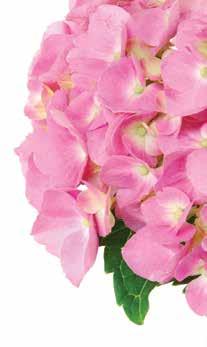

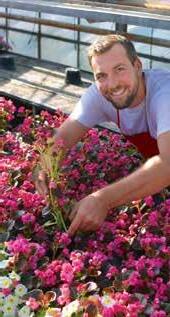



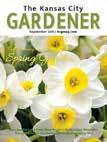
COUNTY
913-299-9300; Mon, Wed, Fri, 9am-4pm
QUESTIONS ABOUT ROSES?
a Rosarian; kcrosehelp@gmail.com; www.kansascityrosesociety.org
The Kansas City Gardener | April 2024 31 Name: Address: City, State, Zip: Phone: E-mail: Where did you pick up The Kansas City Gardener? Please enclose your check payable to The Kansas City Gardener and mail with this form to: P.O. Box 8725, Prairie Village, KS 66208 The Kansas City Gardener is published monthly Jan. through Dec. For convenient mail delivery, complete the form below and send with your check for $35.00. You will receive a oneyear subscription. SUBSCRIBE TODAY CASS COUNTY 816-380-8494; Wed, 9am-noon DOUGLAS COUNTY 785-843-7058; dgcogardenhotline@gmail.com; Mon, Wed, Fri, 1-4pm GREATER KANSAS CITY MISSOURI AREA 816-833-8733 (TREE); Mon-Fri, 9am-noon; mggkc.hotline@gmail.com JOHNSON COUNTY, KS 913-715-7050; Mon-Fri, 9am-4pm; garden.help@jocogov.org JOHNSON COUNTY, MO 660-747-3193; Wed, 9am-noon LEAVENWORTH COUNTY 913-364-5700; Leave a message. A Master Gardener will contact you. MIAMI COUNTY & LINN COUNTY 913-294-4306; Thurs, 8am-noon WYANDOTTE
Ask
Extension Master Gardeners are ready to answer your gardening questions. Hotlines for Gardeners Your Custom Drainage Solution CALL NOW SCHEDULE to (816) 916-5171 Design/Build • LED Lighting Pond Cleaning Services • Maintenence Repair - Leak Diagnosis • Winterization 816-560-0816 LoyalPond.com LoyalPond@gmail.com Our passion is water and providing an enjoyable outdoor oasis for our customers. To see a full list of openings, visit suburbanlg.com/employment/ Now Hiring Outdoor Hardgoods Manager, Plant Sales, Statuary Sales, Equipment Operators, and more! 3 Easy Ways to Apply Now Email resume By Text suburban@suburbanlg.com 13600 Wyandotte, KC MO In Person Questions? Call Human Resources 816-941-4700
Take home the blooms of April and watch the season unfold in your garden. Stop in to any of our locations for a great selection of annuals and perennials.
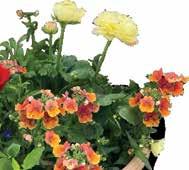

• All
of our Summer Field Farms soil products are locally sourced and produced by us.
• Premium Quality at the best possible price.
• Available at all three stores. One-quart
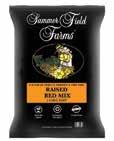

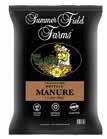

Large trees
trees you might find elsewhere.)
Select shrubs are on sale at all three locations.
32 April 2024 | kcgmag.com
Bloom
six
annuals & perennials start at $5.49 6-pk annuals start at $3.99 Sale 20-50% Off select varieties Spring Tree & Shrub
(from our
own
are arriving daily in
very
farm)
Lenexa and Martin City. (There’s no comparison to the little container
Enjoy a visit to one of our stores or preview the sale at Suburbanlg.com/SpringNurserySale pictured: Royal Raindrops Crab Apple, now $189.99-$229.99
in a
suburbanlg.com K-7 & Prairie Star Pkwy (913) 897-5100 135th & Wornall (816) 942-2921 105th & Roe (913) 649-8700
Value
Bag Summer Field Farms
Let the Good Things







































































































































































































